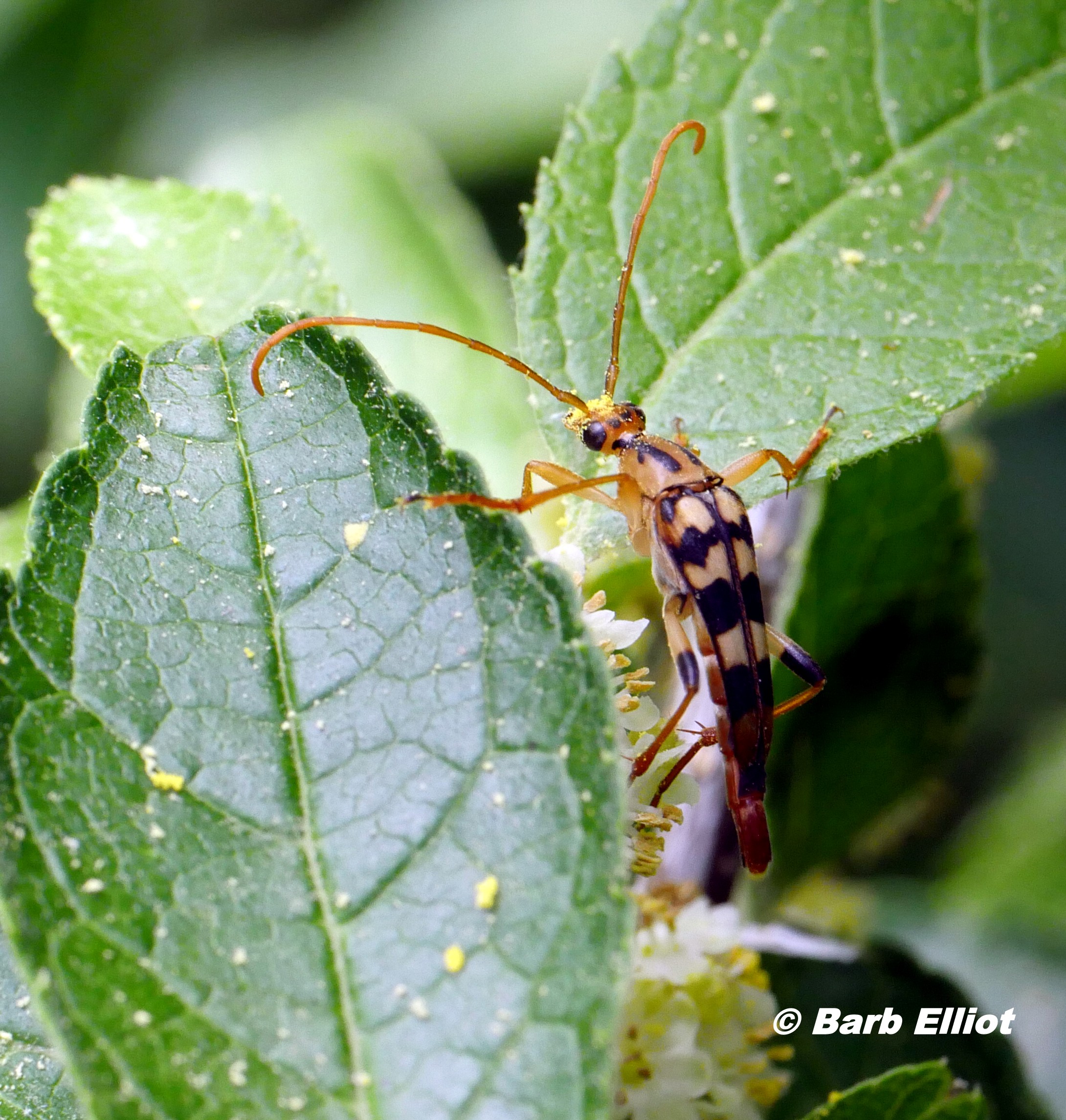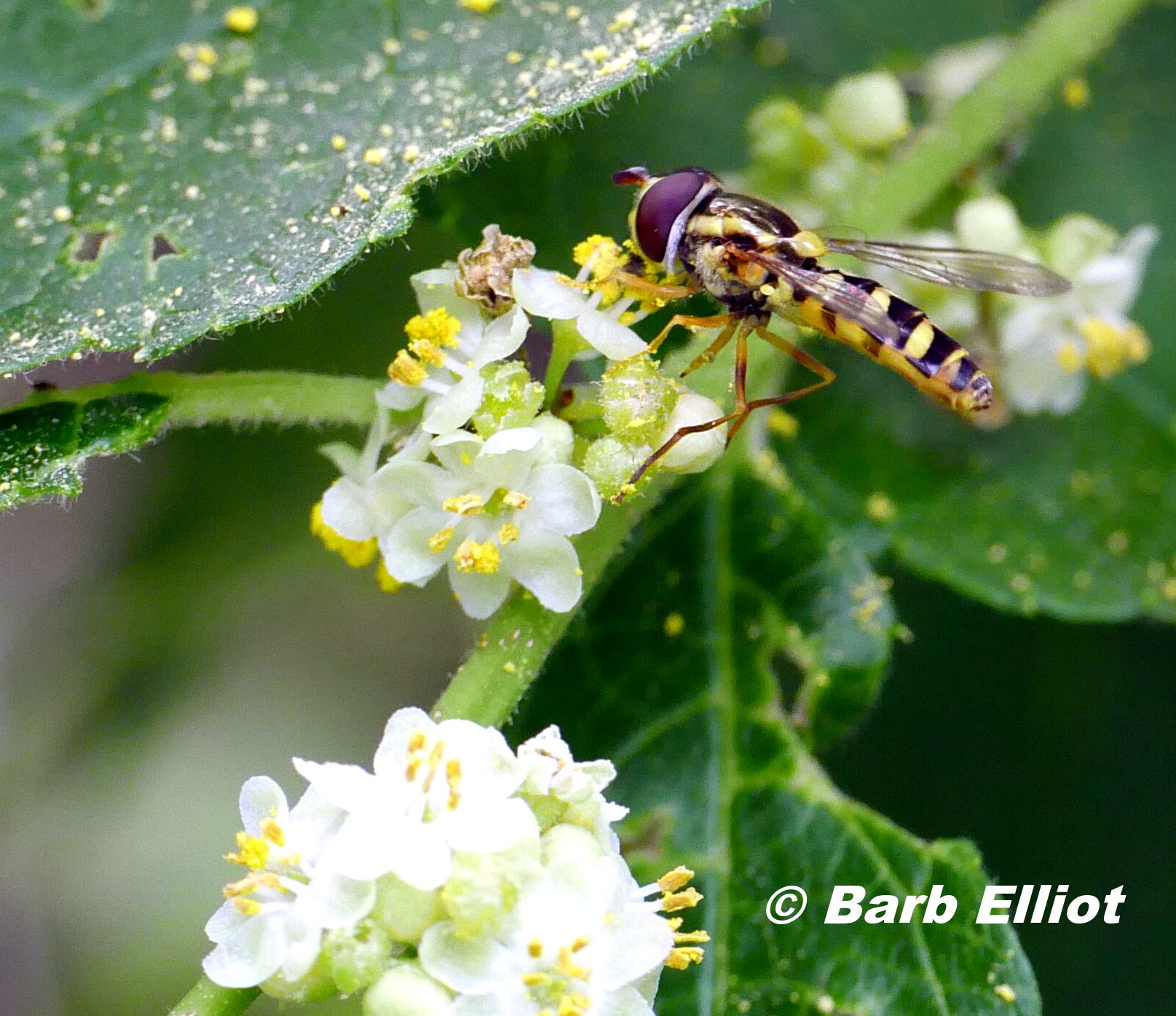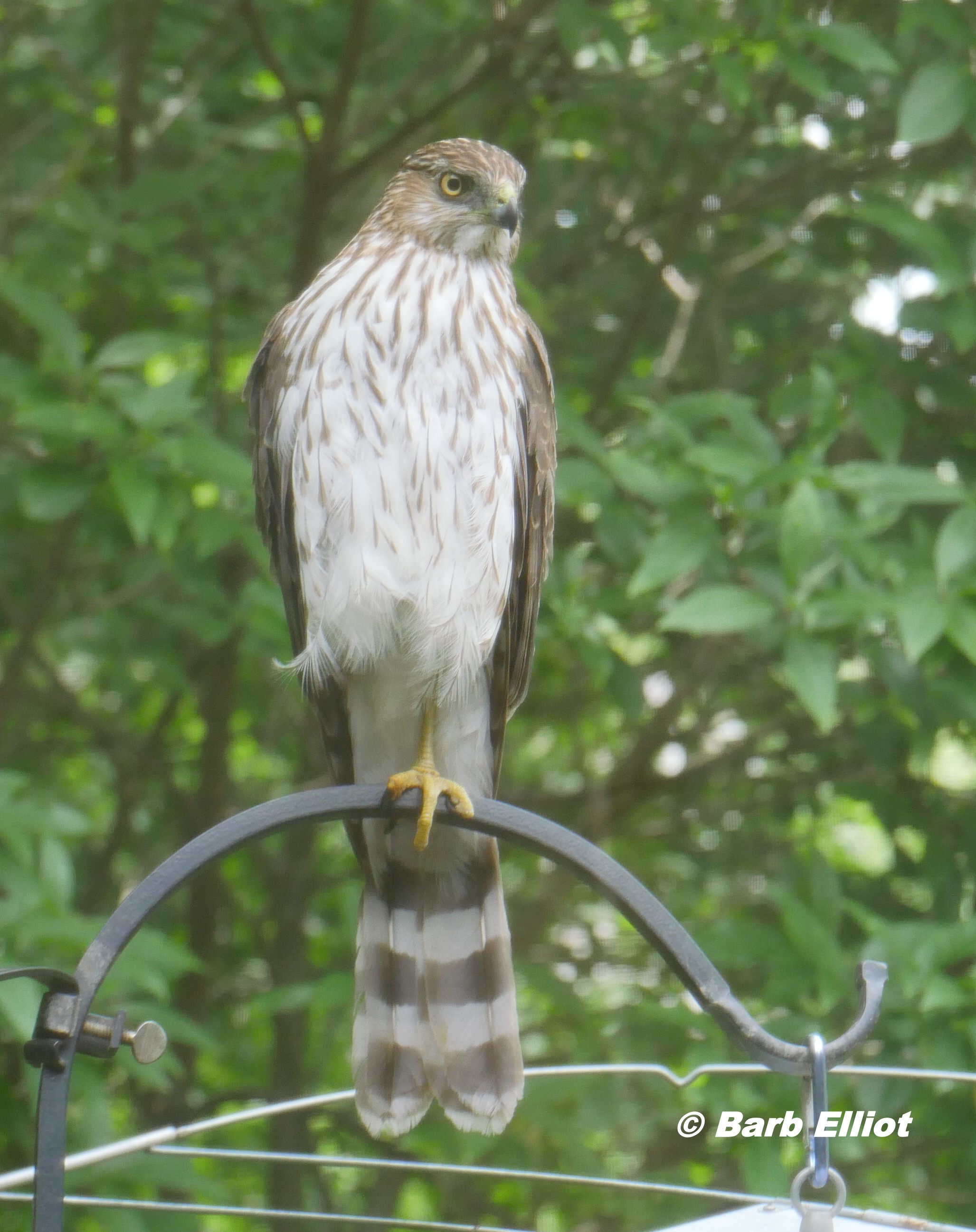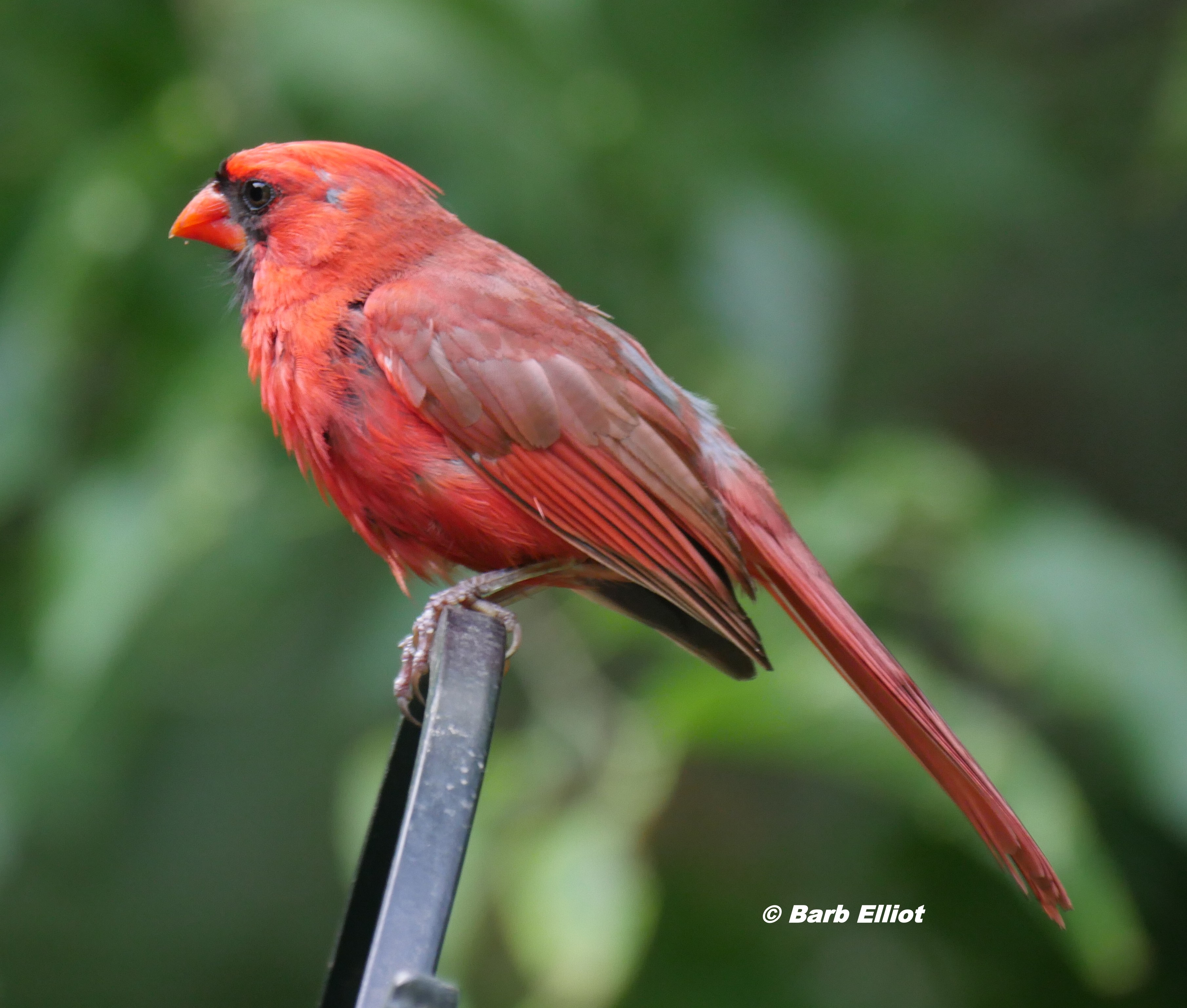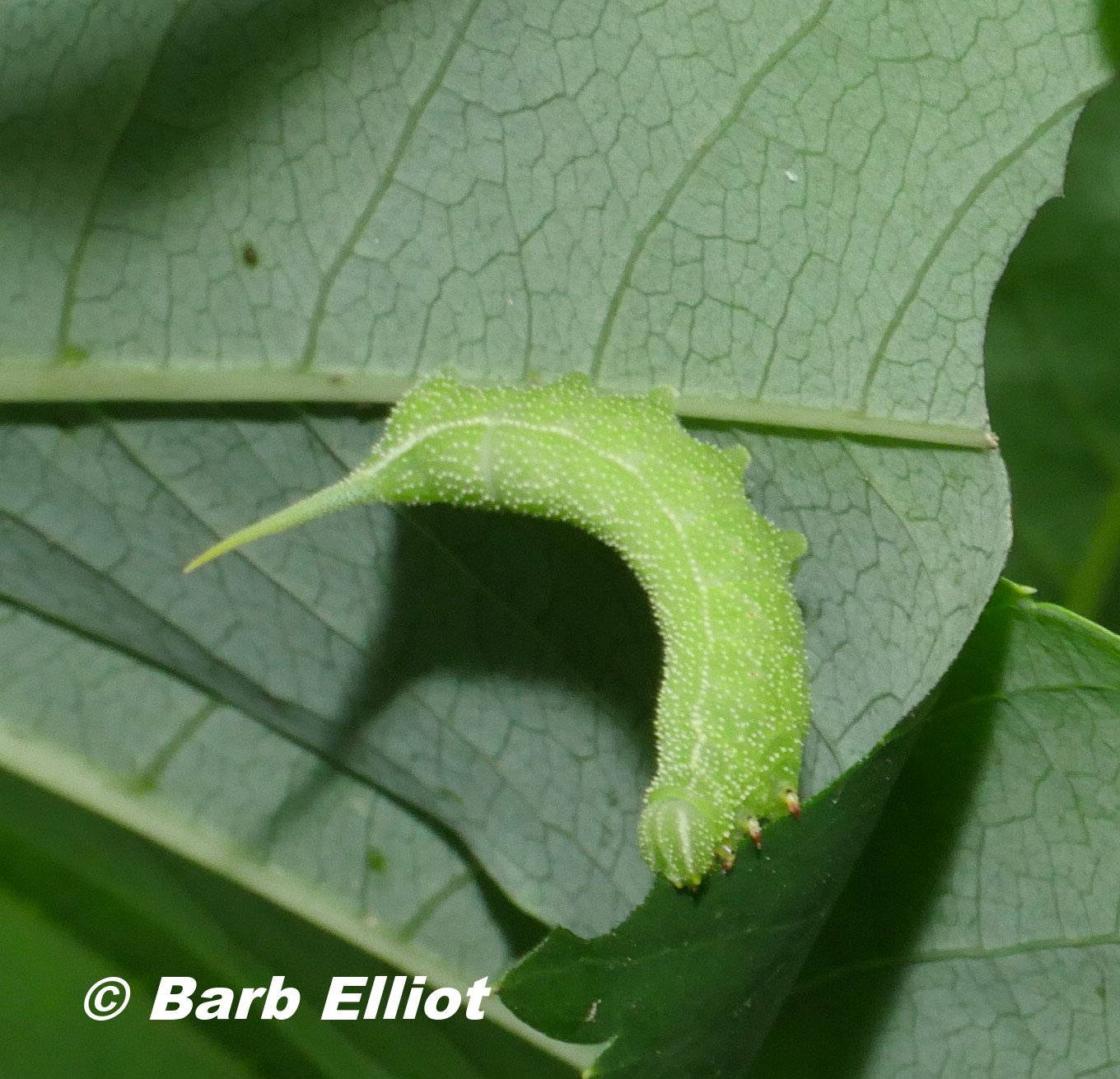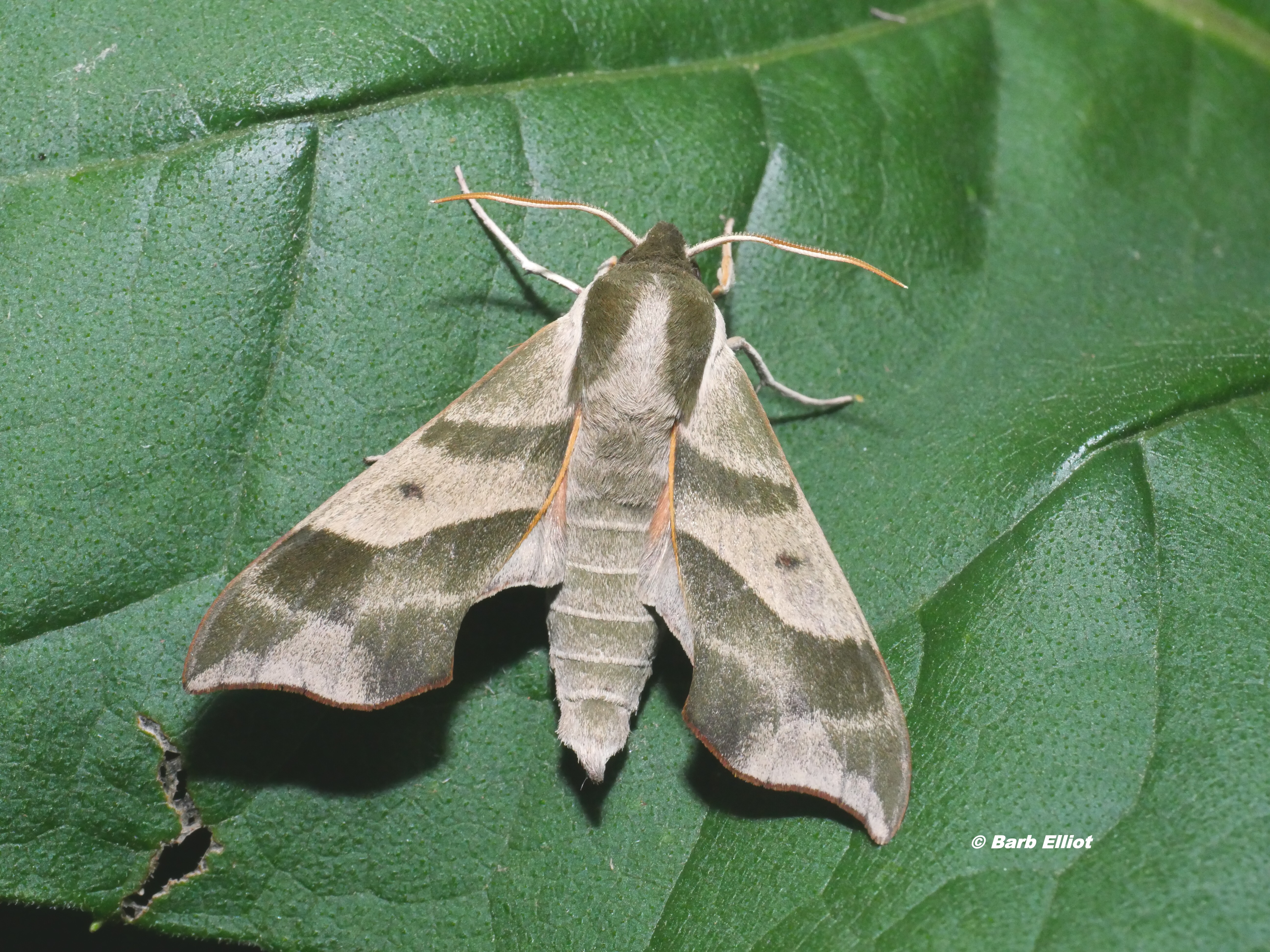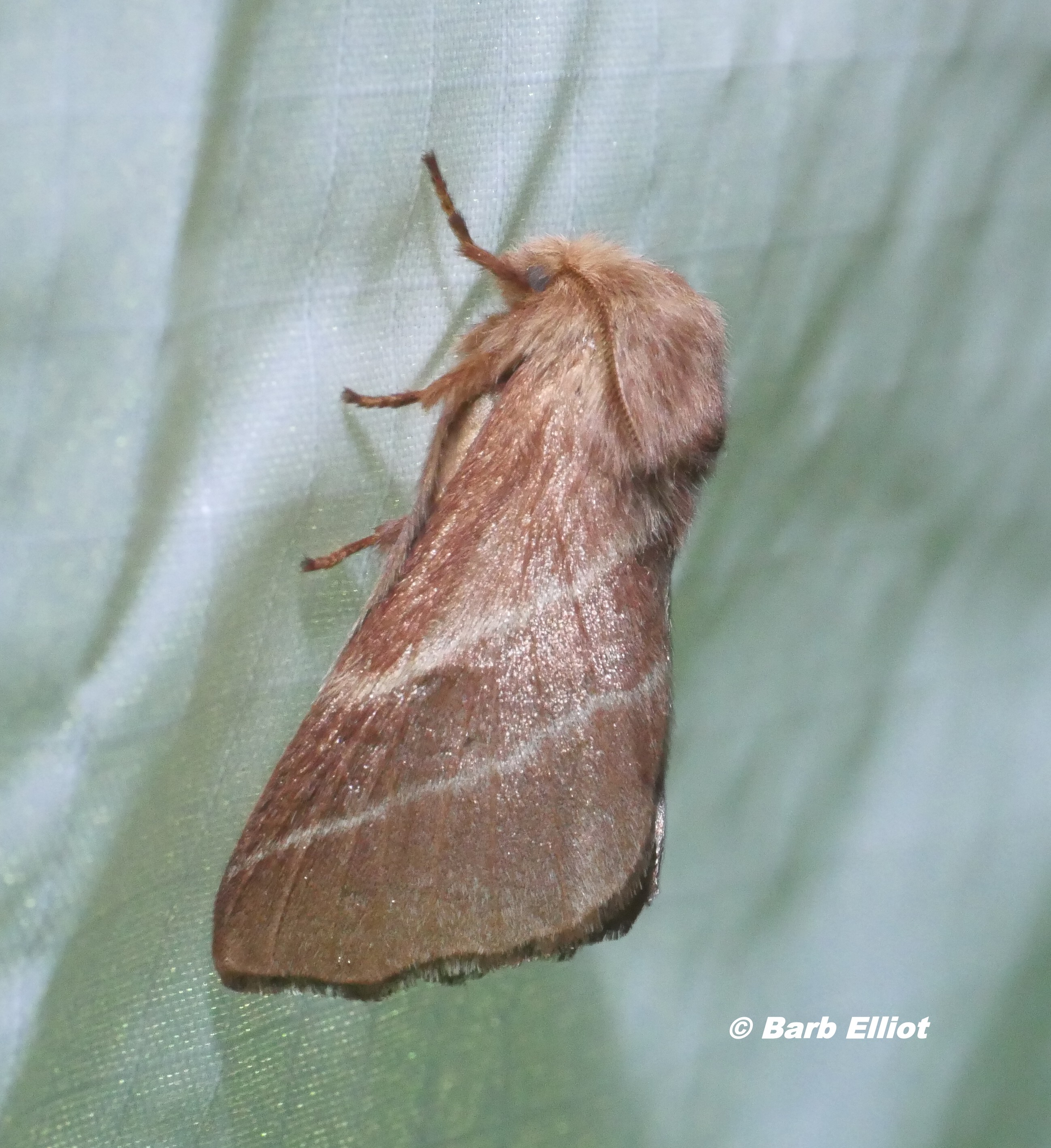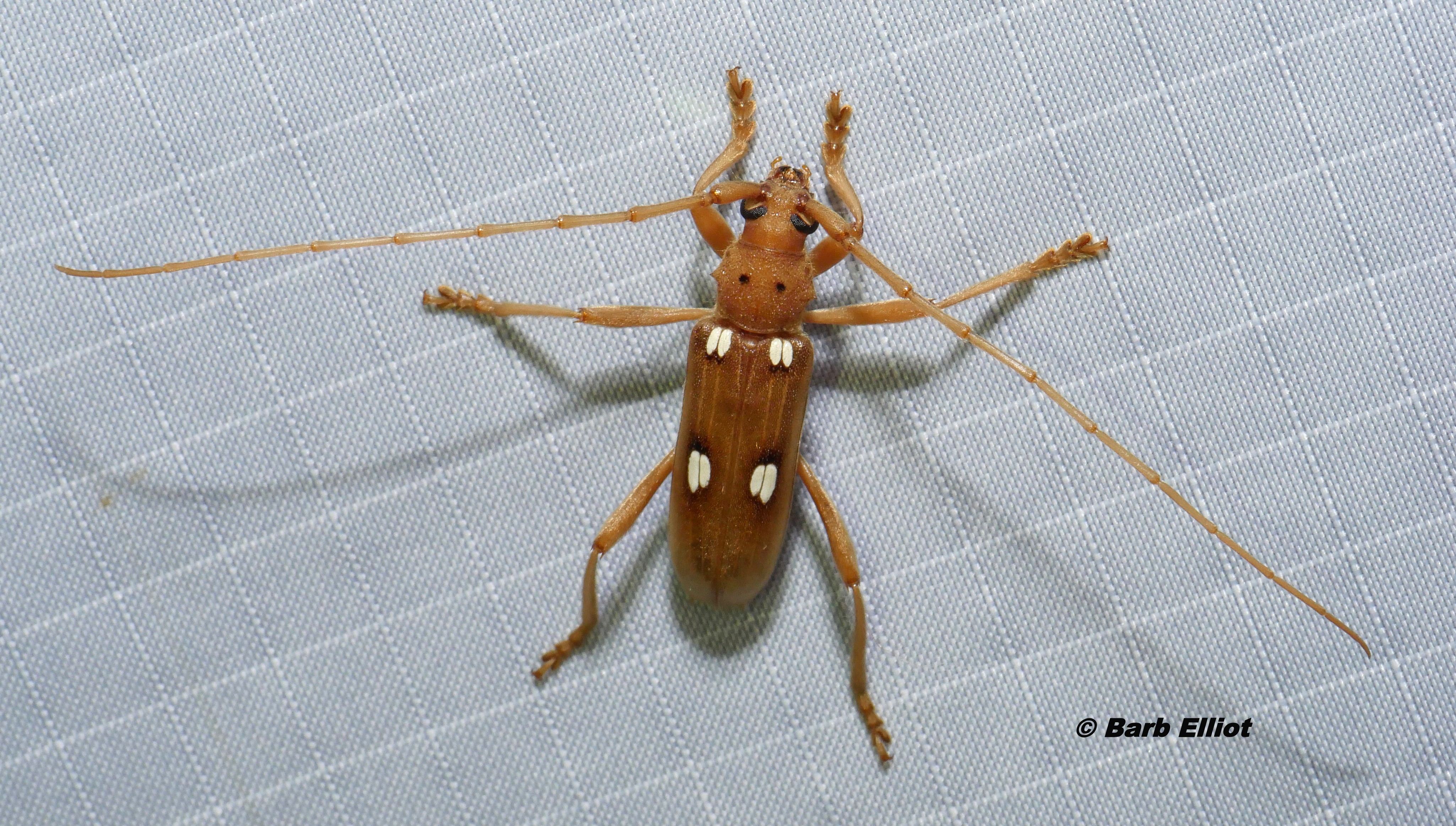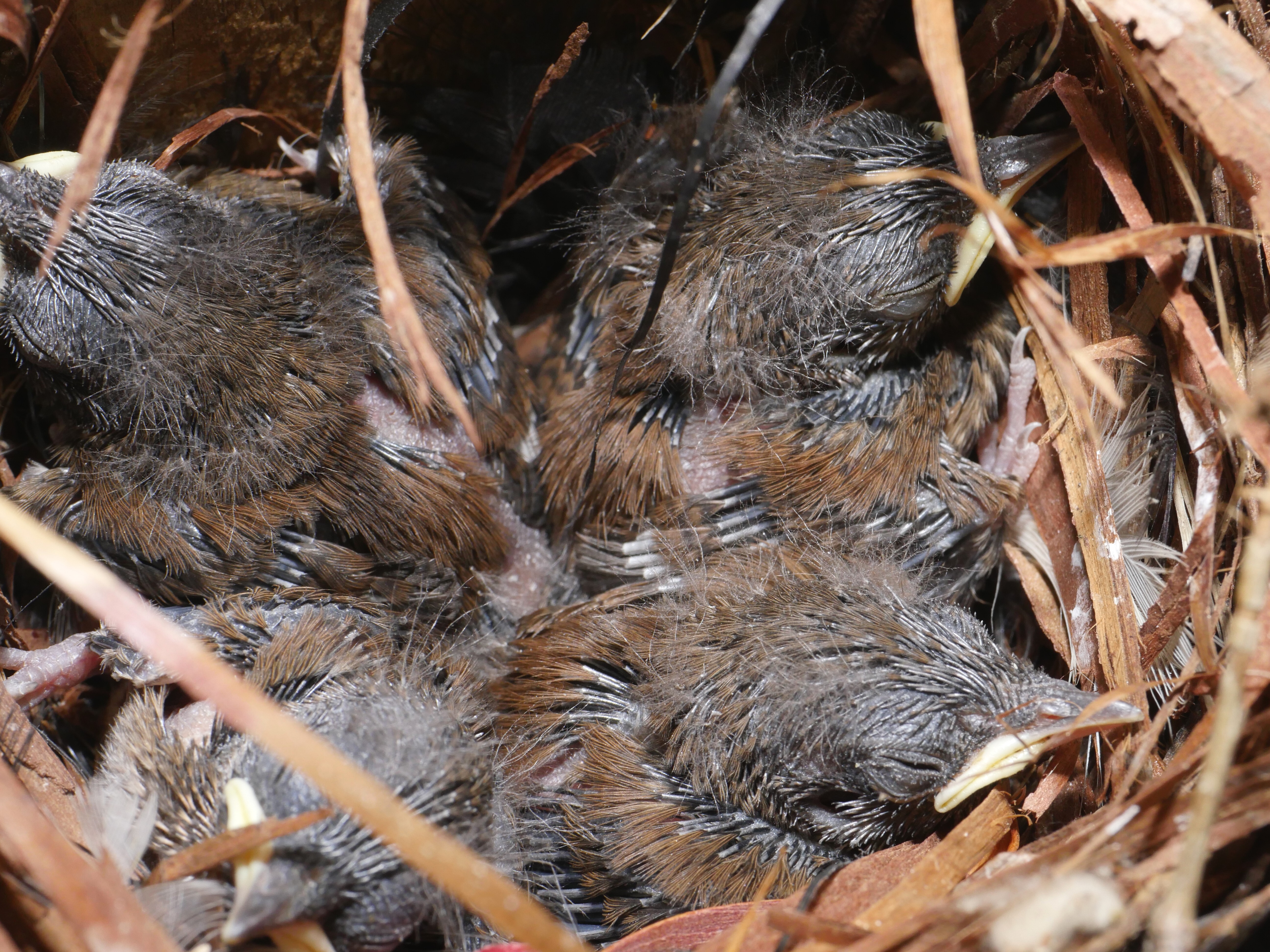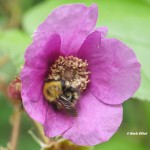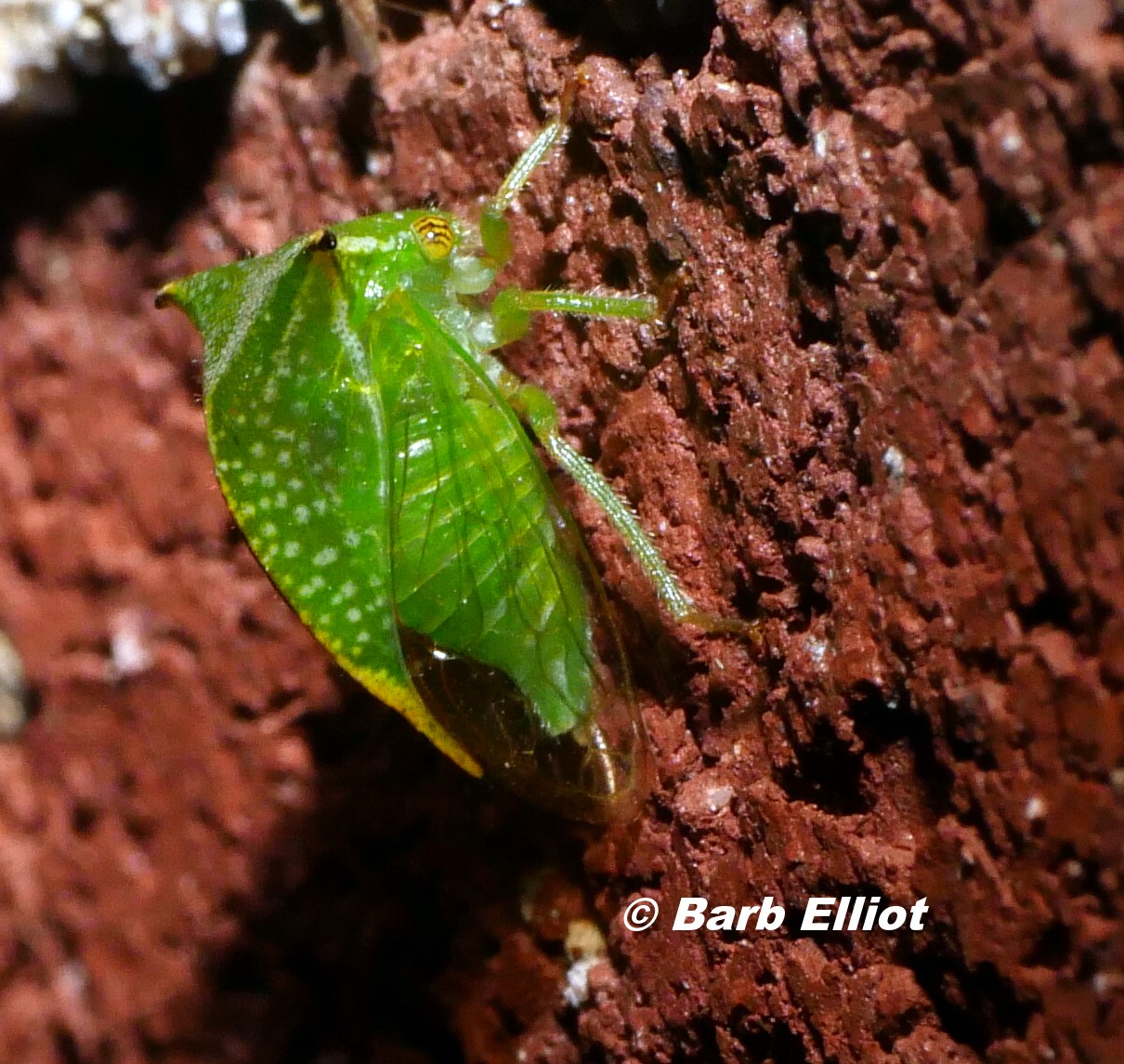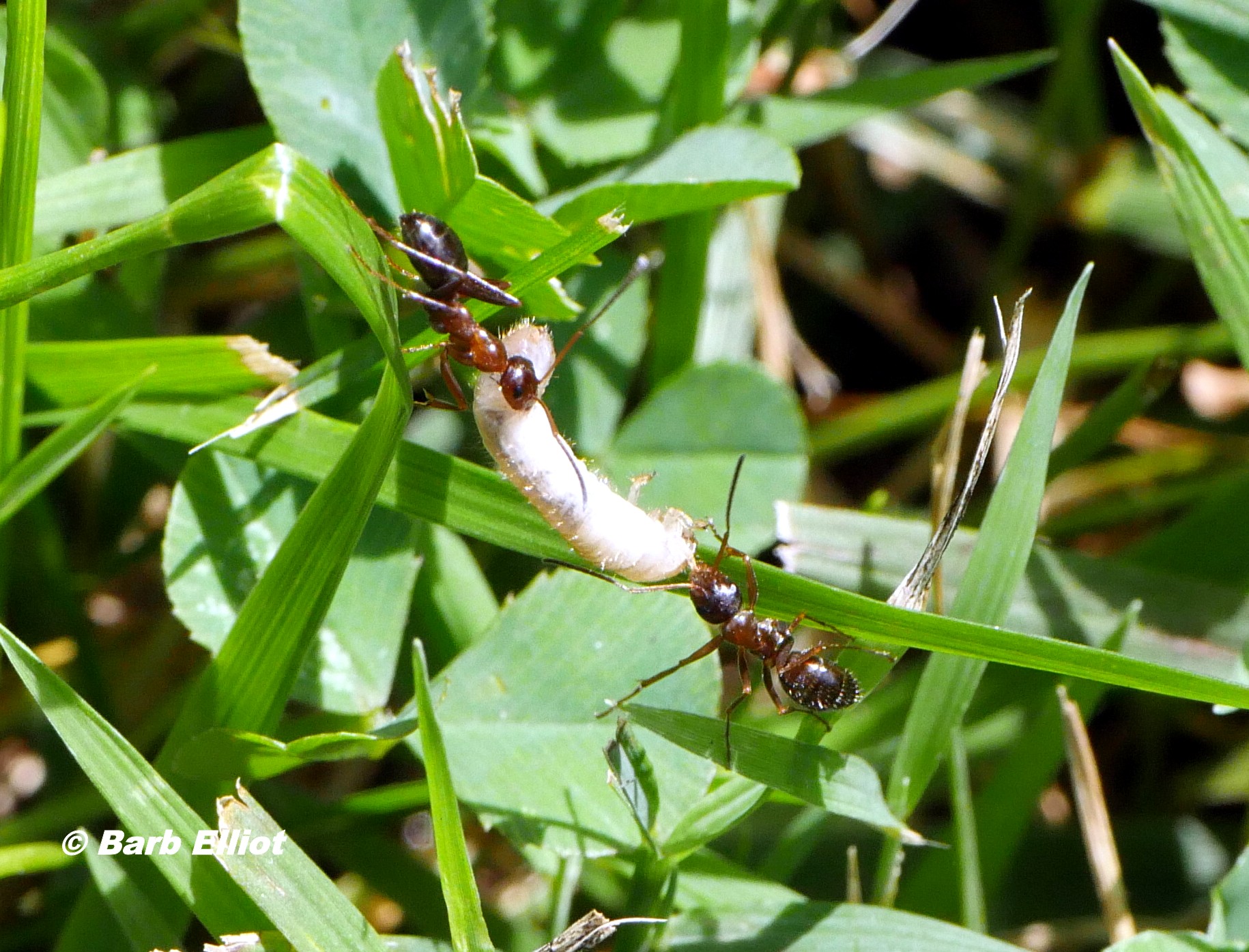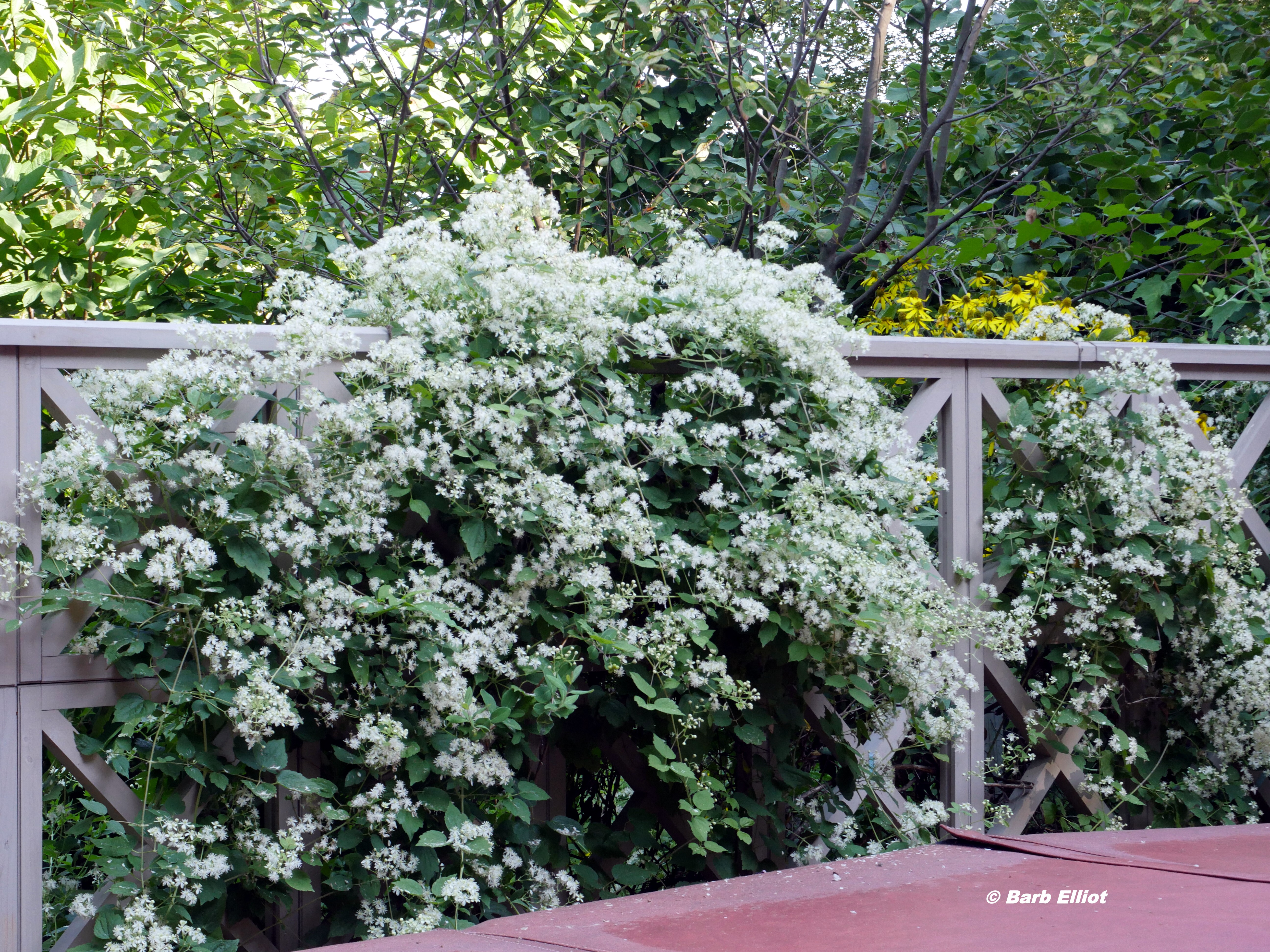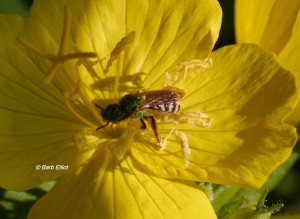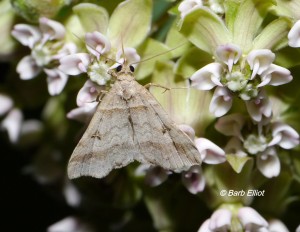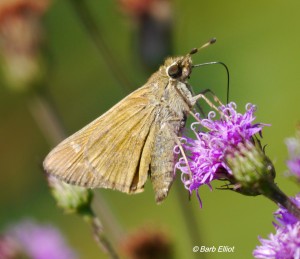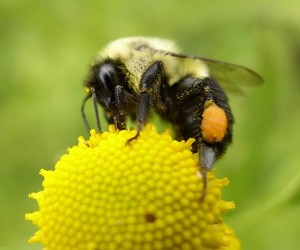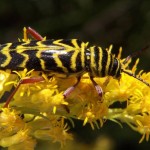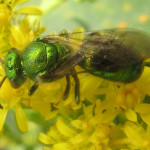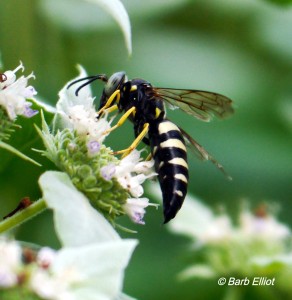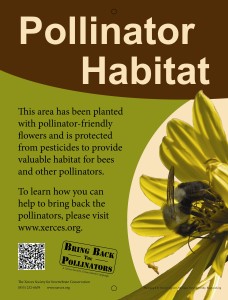By Barb Elliot
When I leave my house to explore my backyard, whether by day or after dark, I enter another world. Transported from daily cares, I anticipate experiencing the wonders of nature. What’s happening at this season? What creatures will I encounter? What mysteries will unfold? I am rarely disappointed. Life is abundant in my yard because the numerous native plants I’ve planted meet the food and shelter needs of many animals.
This summer I photographed some of what I observed. Here are highlights. Enlarge any photo by clicking on it.
Early Summer
Interesting pollinators gather nectar and/or pollen from my Highbush Blueberry flowers, including a Flower Longhorn Beetle and an unknown flower fly – a good Yellow Jacket wasp mimic. A native Green Sweat Bee on a Black-eyed Susan is covered with yellow pollen grains.
In my pond, a Northern Green Frog awaits its next meal. Near the pond edge an Orchard Orbweaver spider is ready to pounce on prey caught in its web.
A Cooper’s Hawk, unsuccessful at catching a songbird, watches for birds to return but eventually leaves without a meal. A male Northern Cardinal, which is starting to molt, returns warily to the feeders.
Wild Bergamot flowers attract a day-flying Hummingbird Clearwing Moth as well as many bumble bees.
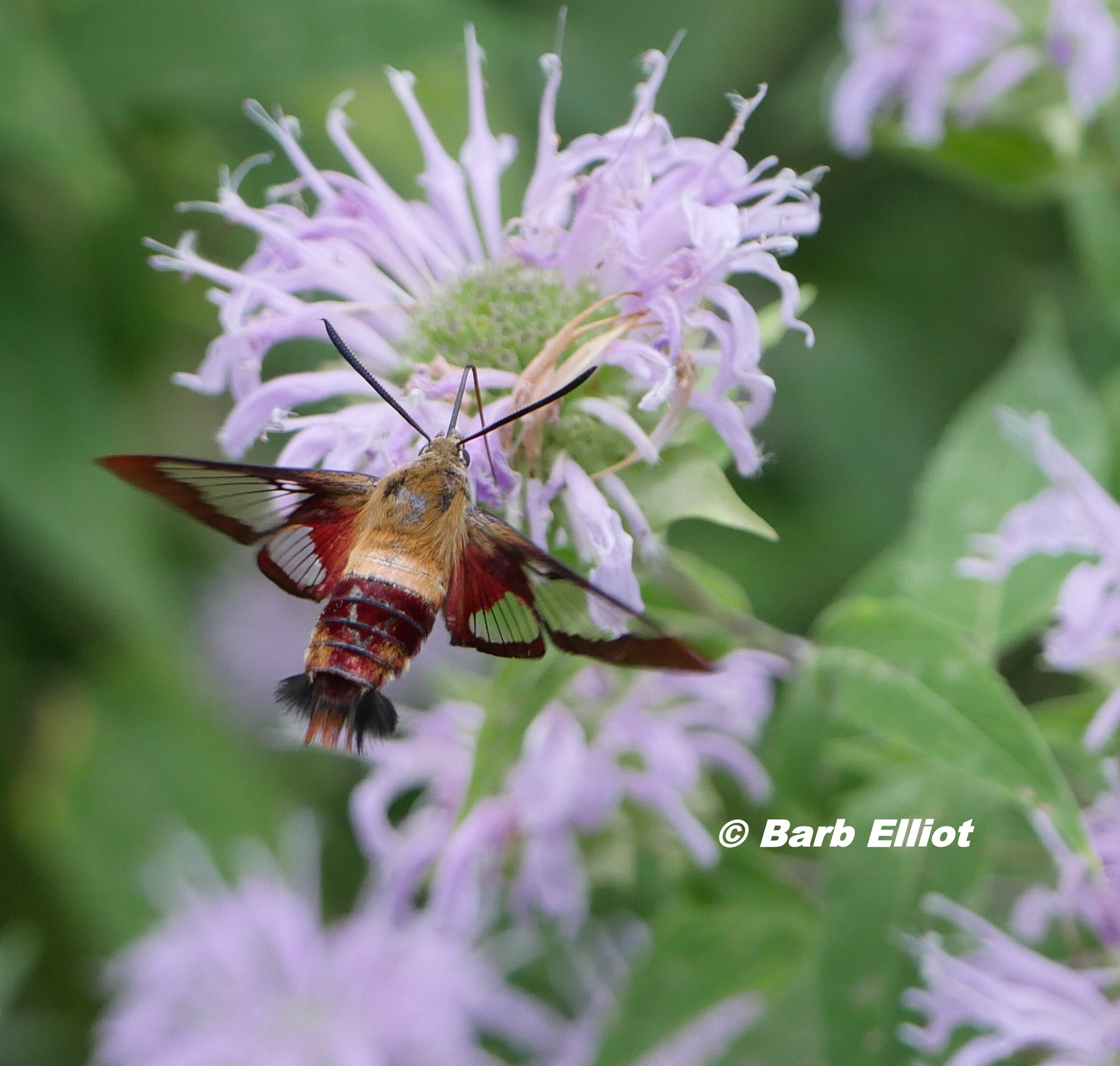
Hummingbird Clearwing Moth (Hemaris thysbe) sips nectar from Wild Bergamot (Monarda fistulosa). © Barb Elliot. Click to enlarge.
One night, I find mating Red Milkweed Beetles on a milkweed plant and a Virginia Creeper Sphinx moth caterpillar on a Virginia Creeper vine. On another night, an adult Virginia Creeper Sphinx moth comes to my lights.
A Tent Caterpillar Moth, which I find attractive, also flies in. Yes — this is the adult moth that comes from the Tent Caterpillars that make webs in my Black Cherry (Prunus serotina) trees.
Midsummer
In July, I find a variety of beetles. My favorite, the Dogbane Beetle, is on a Dogbane plant. A tiny (less than 1/4 inch) colorful beetle, the Mottled Tortoise Beetle appears during the day (wearing its little translucent skirt!). A longhorn Ivory-marked Beetle, comes to night lighting.
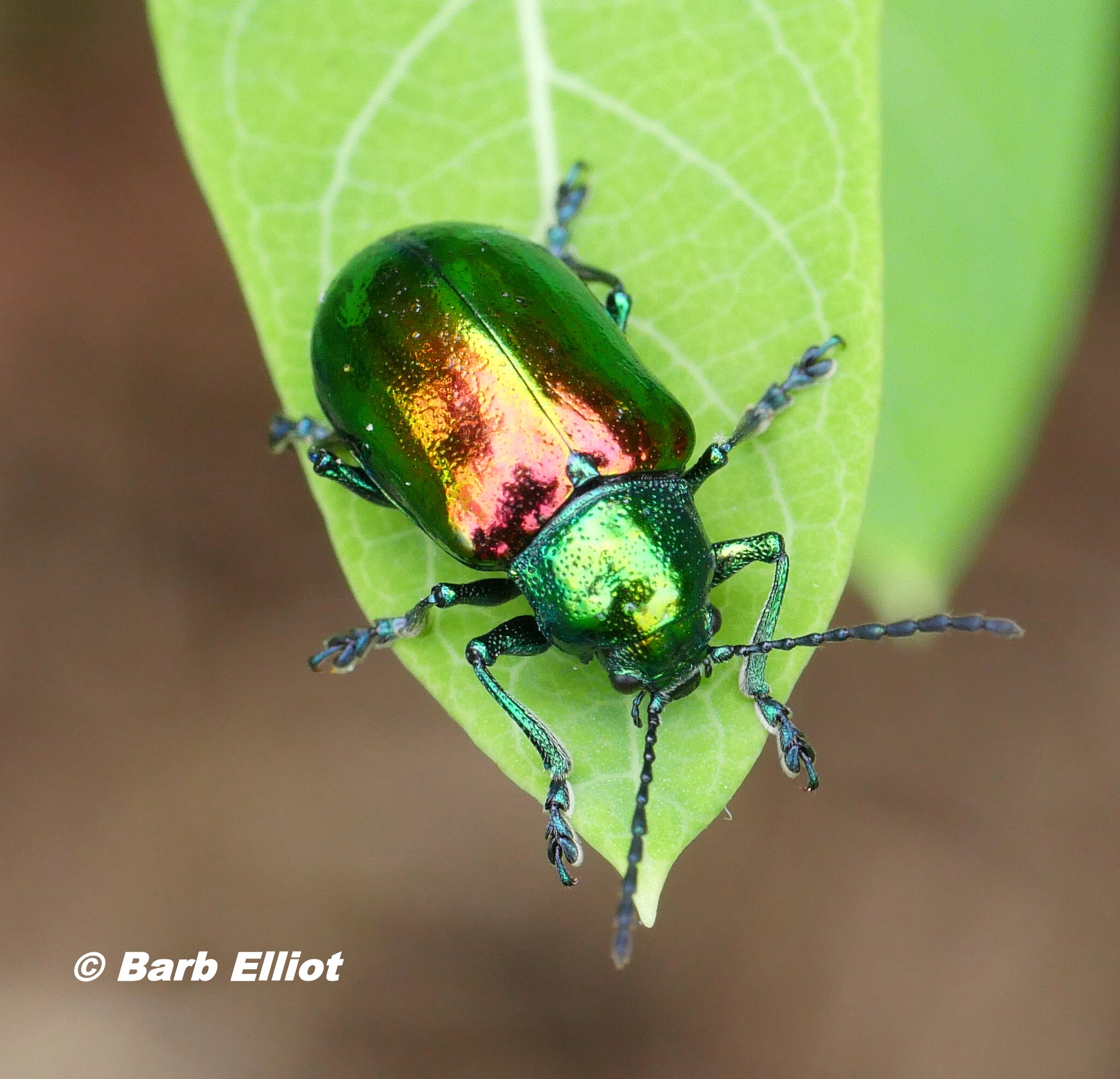
Dogbane Beetle (Chrysochus auratus) on Dogbane plant (Apocynum cannabinum). © Barb Elliot. Click to enlarge.
The right side of the patio area sports both Cardinal Flower and Great Blue Lobelia . Pickerel Rush grows in the pond on the left. The tall plants with yellow flowers in the background are Cup Plant. Cardinal Flower nectar is enjoyed by a Spicebush Swallowtail that lost part of its left hindwing. Probably a hungry bird tried unsuccessfully to capture this butterfly.
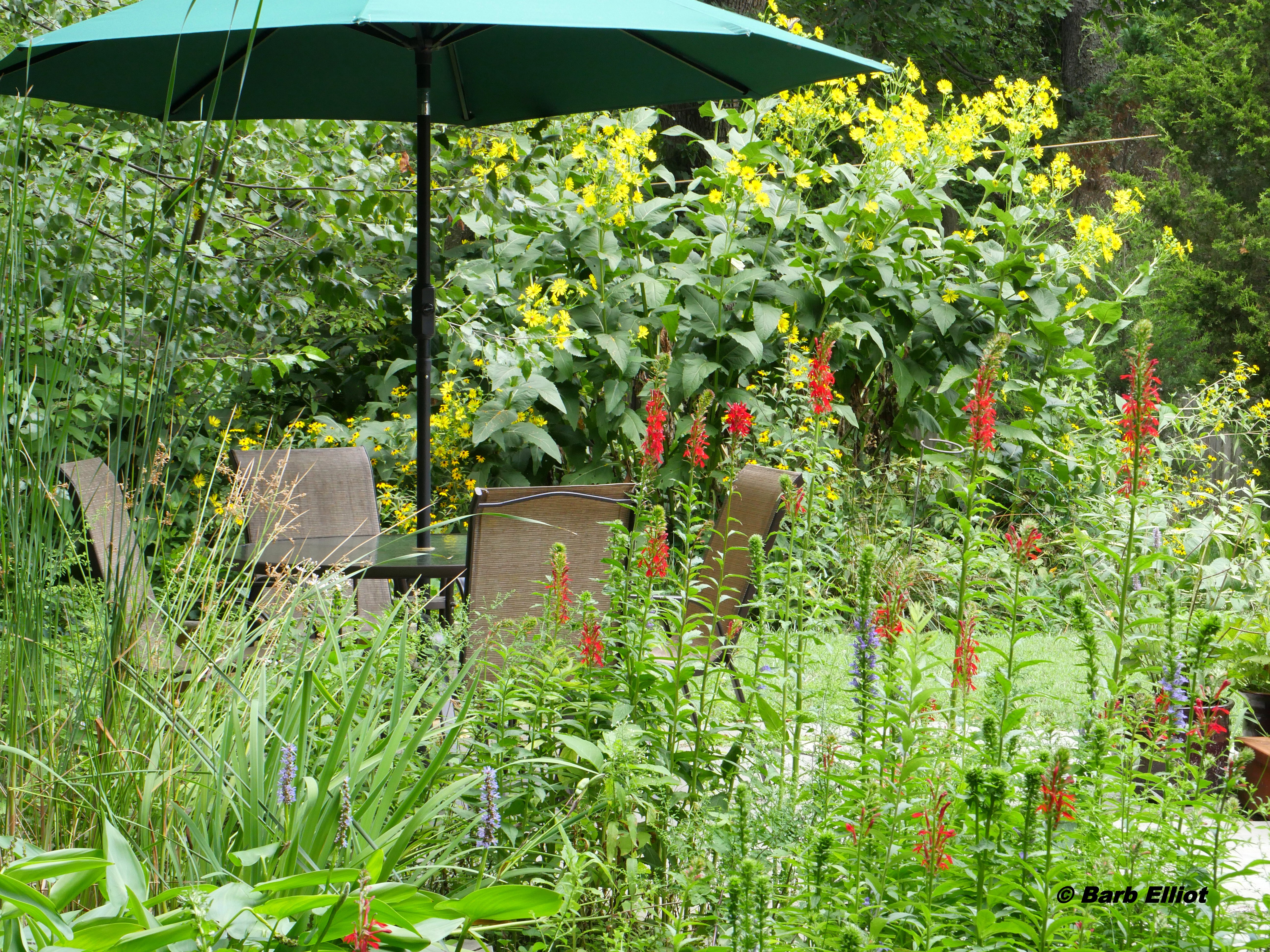
Cardinal Flower (Lobelia cardinalis) and Great Blue Lobelia (Lobelia siphilitica) on right, blue Pickerel Rush (Pontederia cordata) flowers in pond on left. Yellow flowers of the tall Cup Plant (Silphium perfoliatum) in background. © Barb Elliot. Click to enlarge.
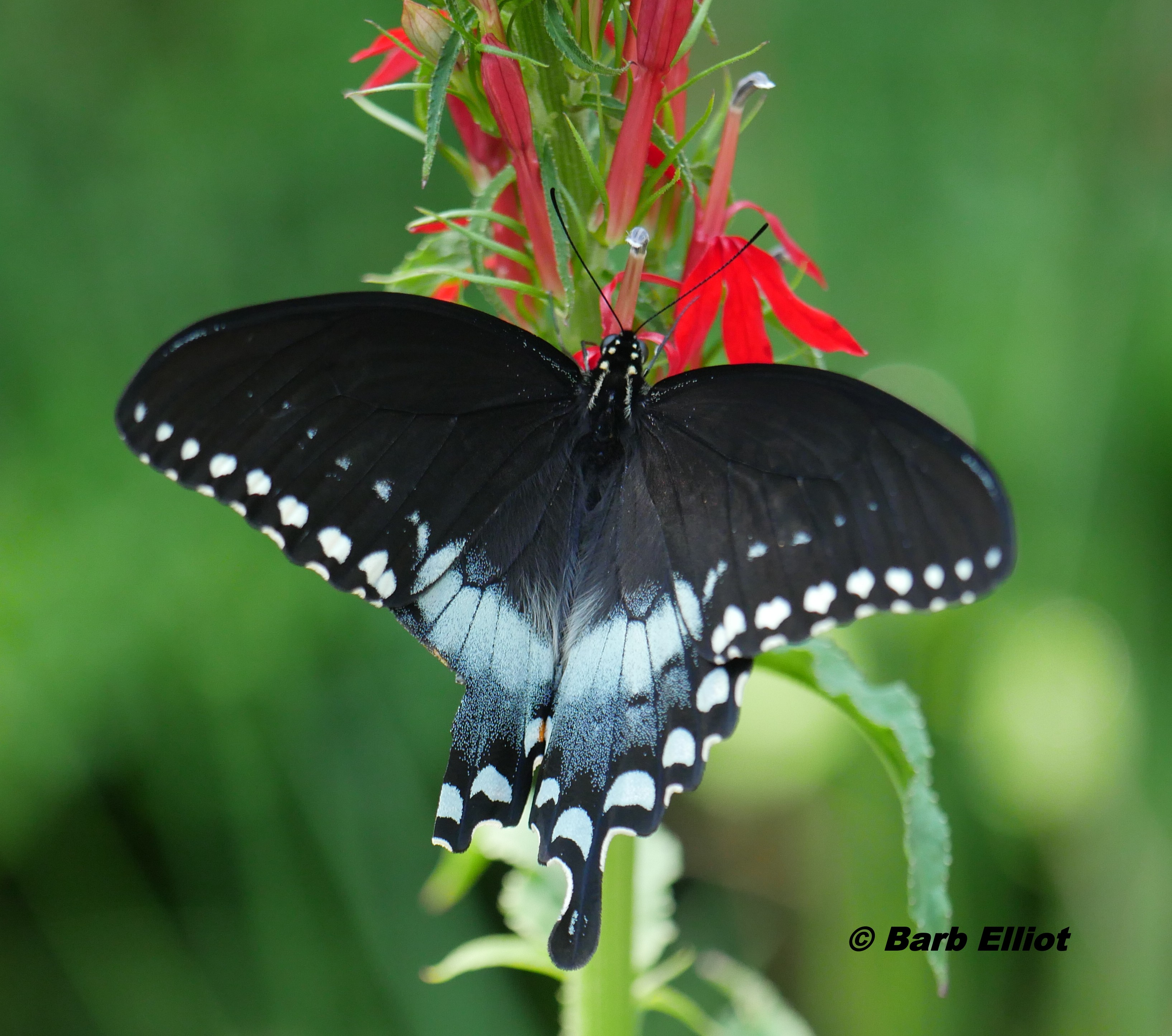
Spicebush Swallowtail (Papilio troilus) missing part of left hindwing on Cardinal Flower (Lobelia cardinalis). © Barb Elliot. Click to enlarge.
Cup Plant attracts many pollinators, including bees, butterflies, and moths. At night I find a Grape Leaffolder Moth sipping nectar. One of many bumble bees that worked hard gathering nectar and pollen during the day sleeps on a Cup Plant flower. At night, I often find bumble bees sound asleep on flowers in my garden.
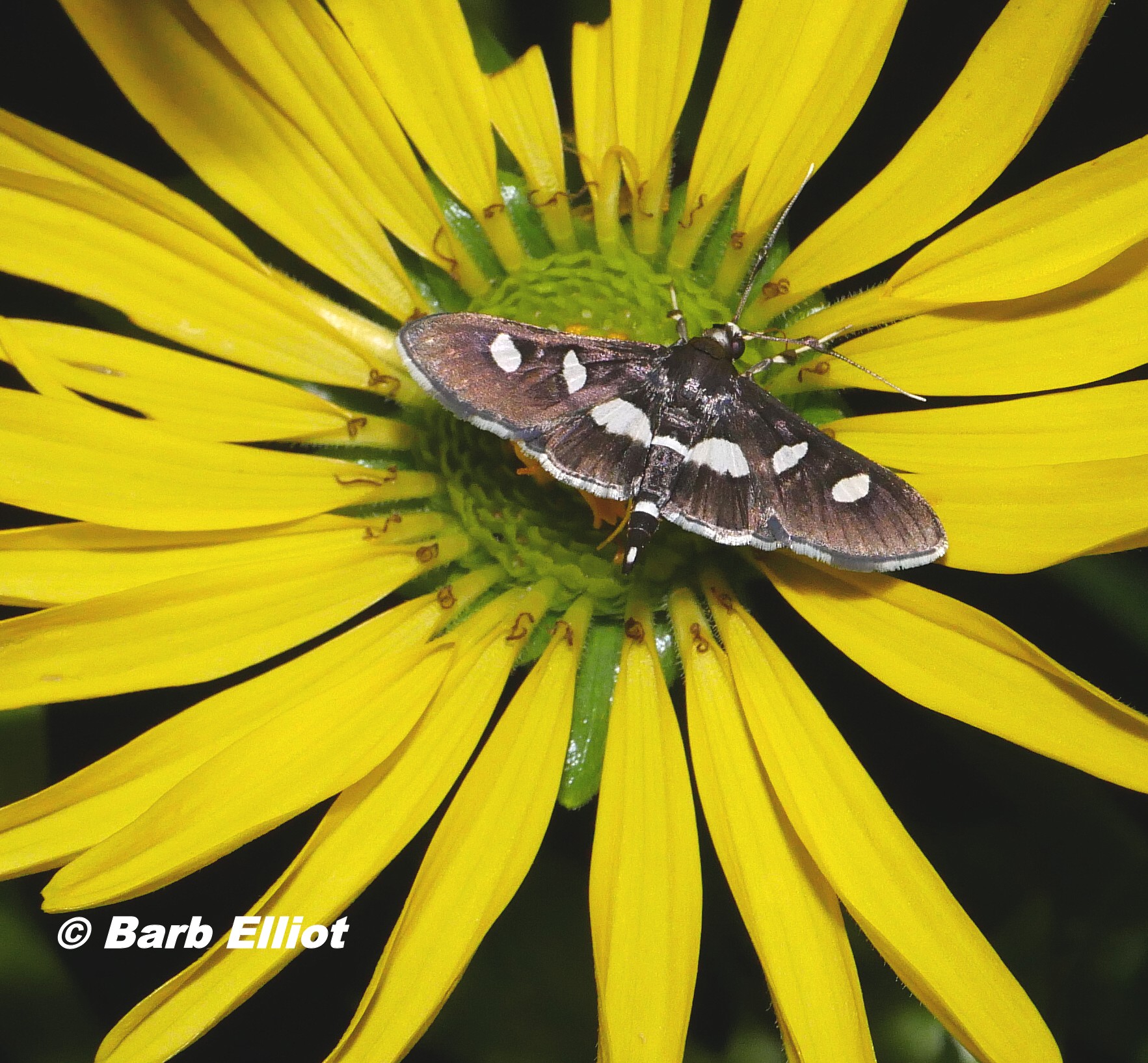
Grape Leaffolder Moth (Desmia funeralis) on Cup Plant at night. (Silphium perfoliatum). © Barb Elliot. Click to enlarge.
After raising one successful brood, the House Wrens have a second set of nestlings that will soon leave the nest box.
Several types of native bees are busy pollinating my flowers. Of special interest, bumble bees are performing buzz pollination on my Flowering Raspberry flowers. Bumble bees vibrate their wings at specific frequencies to get some species of flowers to release their pollen. Note that bumble bees are used for buzz pollination of a number of crops, including tomatoes, blueberries, eggplants, and cranberries. The non-native honeybee is not able to buzz pollinate.
To watch and hear bumble bees performing buzz pollination in my yard, click here for the video.
I find a small green Nessus Sphinx moth caterpillar on native Enchanted Nightshade (Circaea lutetiana) and decide to raise it in a small enclosure with several inches of loose soil. I feed it fresh leaves and within a week or so, it grows to over two inches long, molts into a brown caterpillar, and later burrows into the soil to pupate. I have to wait until next spring to see it emerge as a beautiful day-flying hummingbird-like moth.

Nessus Sphinx Moth (Amphion floridensis) caterpillar – early instar. © Barb Elliot. Click to enlarge.
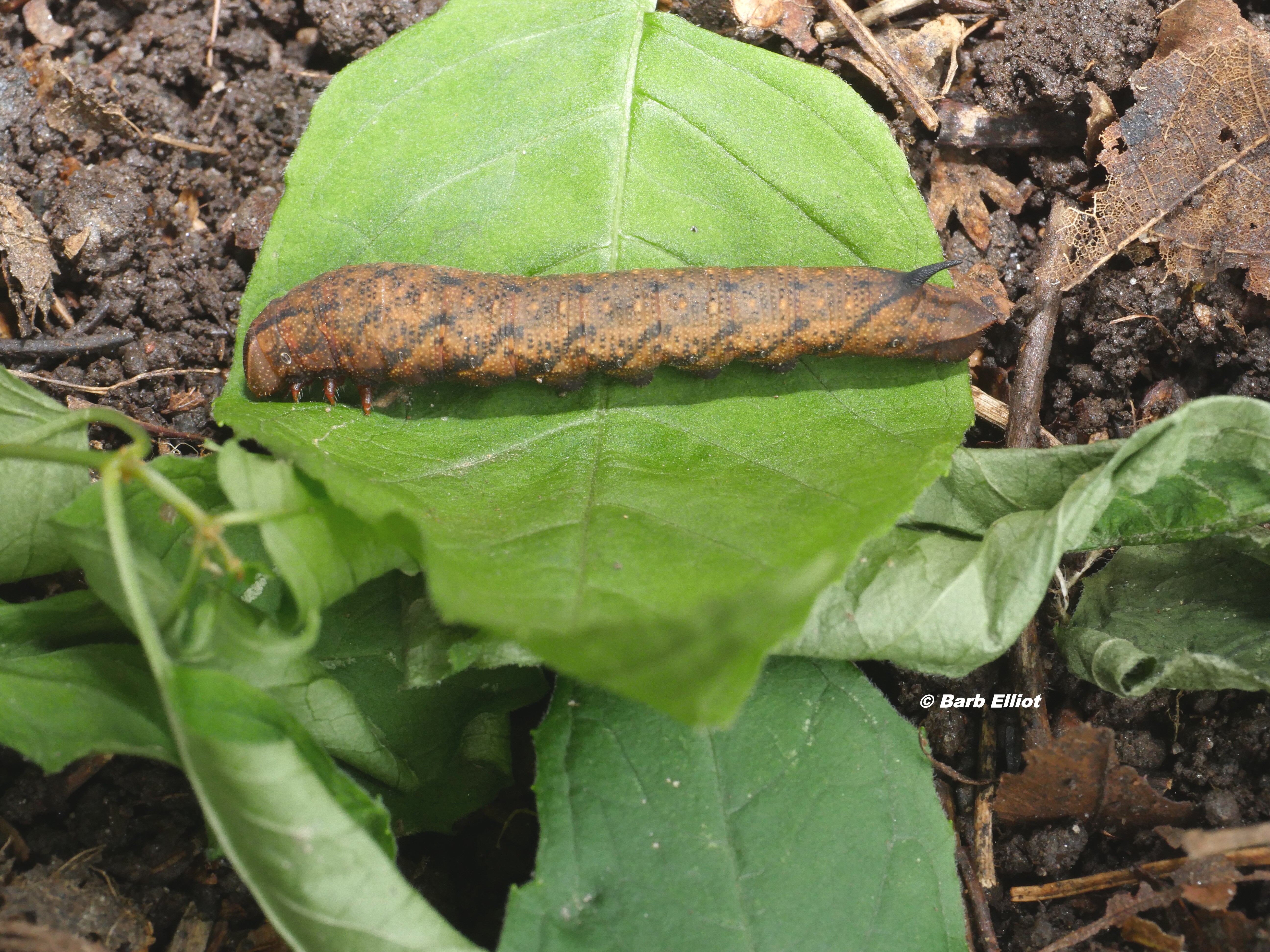
Nessus Sphinx Moth (Amphion floridensis) caterpillar – last instar before pupation. © Barb Elliot. Click to enlarge.
One night a strange-looking treehopper, possibly a Buffalo Treehopper, appears near my porch light. Even more strange and ominous-looking, a very large robber fly the size of a large wasp hunts from a perch above my pond. These flies prey on large insects such as bees and wasps and will hang from one foot while devouring a victim.
Late Summer
A Shadow Darner dragonfly dries and expands its wings after emerging from the pond where it spent its nymphal stage. The nymph recently crawled out of the pond and shed its exoskeleton. Because I find numerous shed skins (exuvia) during the summer, I know that my pond produces a good number of dragonflies.
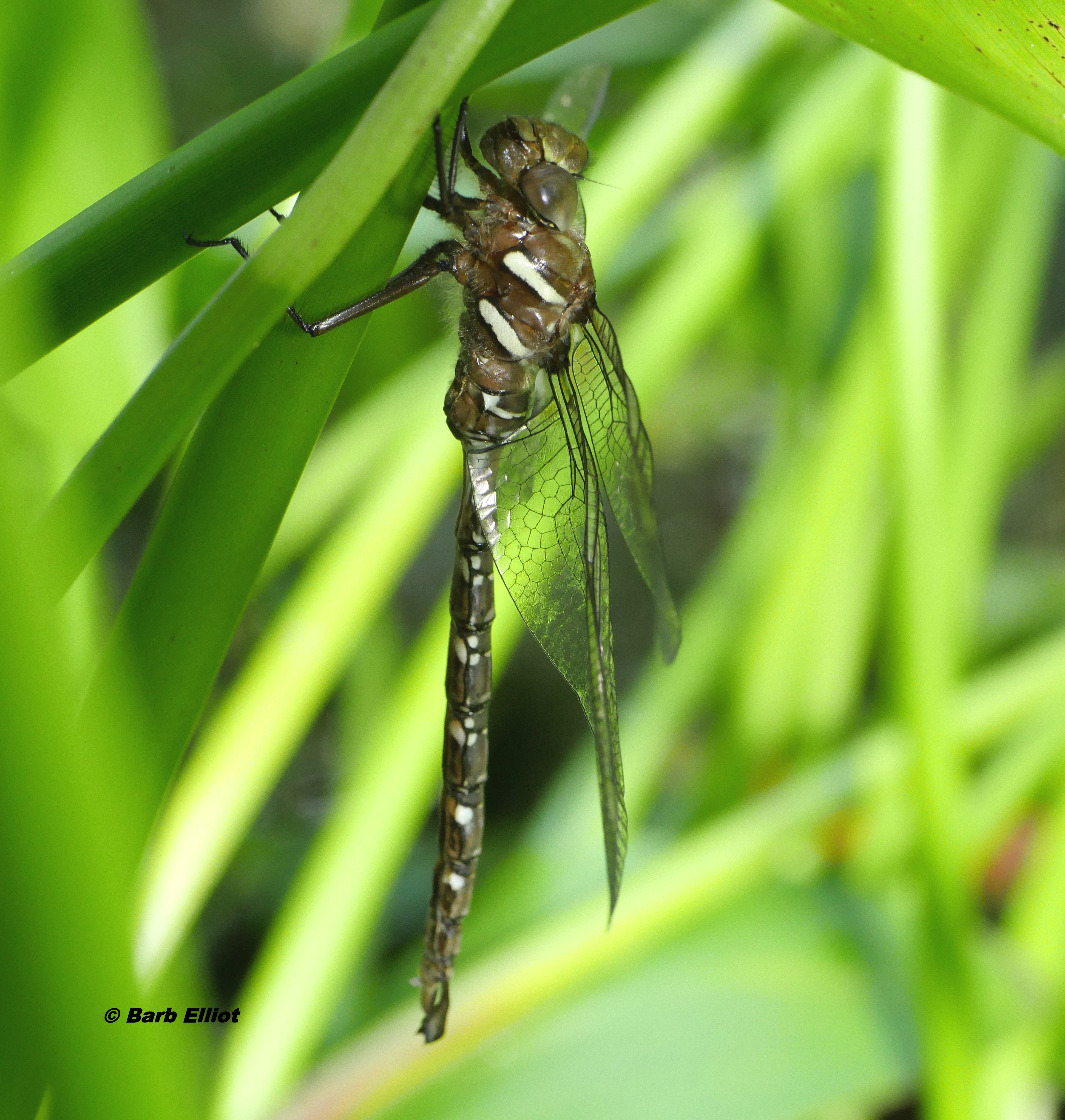
Newly emerged Shadow Darner (Aeshna umbrosa) dragonfly dries and expands its wings. © Barb Elliot. Click to enlarge.
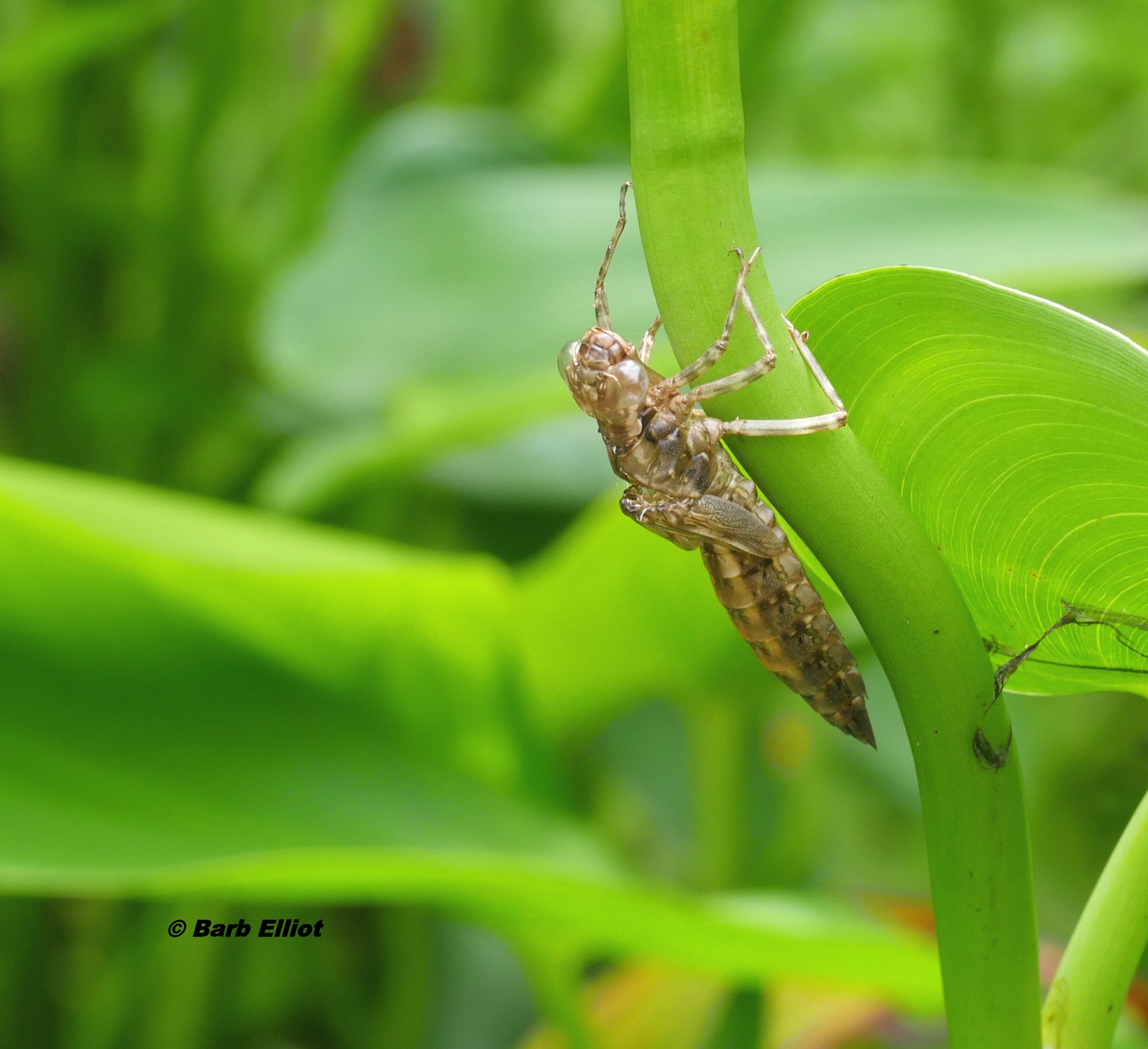
The shed skin (exuvia) from which a dragonfly emerged still hangs from a stem in the pond. © Barb Elliot. Click to enlarge.
Native bees continue to actively collect pollen. This one deposits the white pollen of Upland Ironweed into large pollen baskets on its hind legs.
Eastern Tiger Swallowtails and Skippers are frequent visitors at my Garden Phlox. I am happy to find a Monarch, too, but regret that this is the only one I’ve seen in my yard all summer. It’s a female, so hopefully she laid eggs on my milkweed.
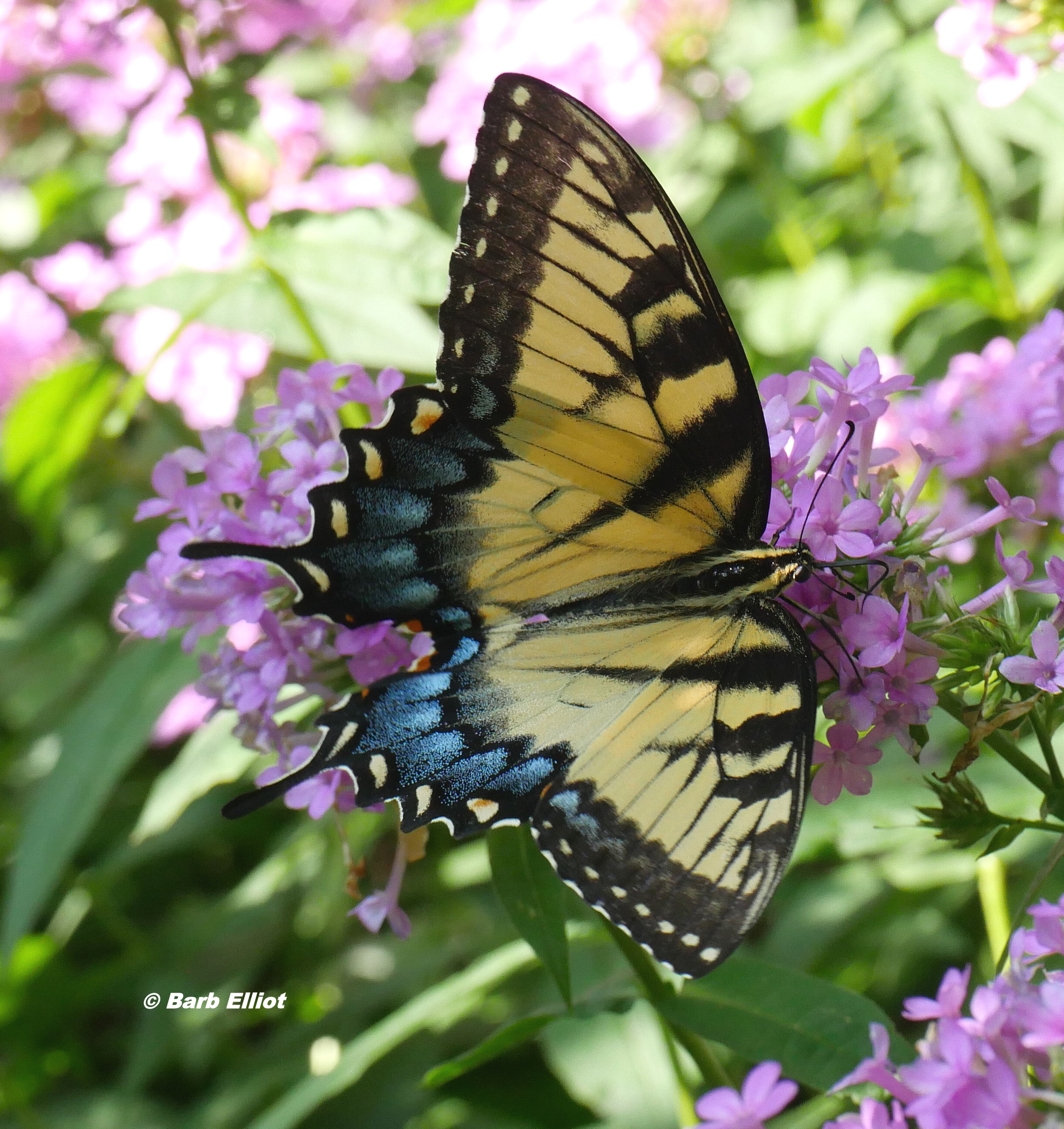
Eastern Tiger Swallowtail (Papilio glaucus) on Garden Phlox (Phlox paniculata ‘Jeana’). © Barb Elliot. Click to enlarge.
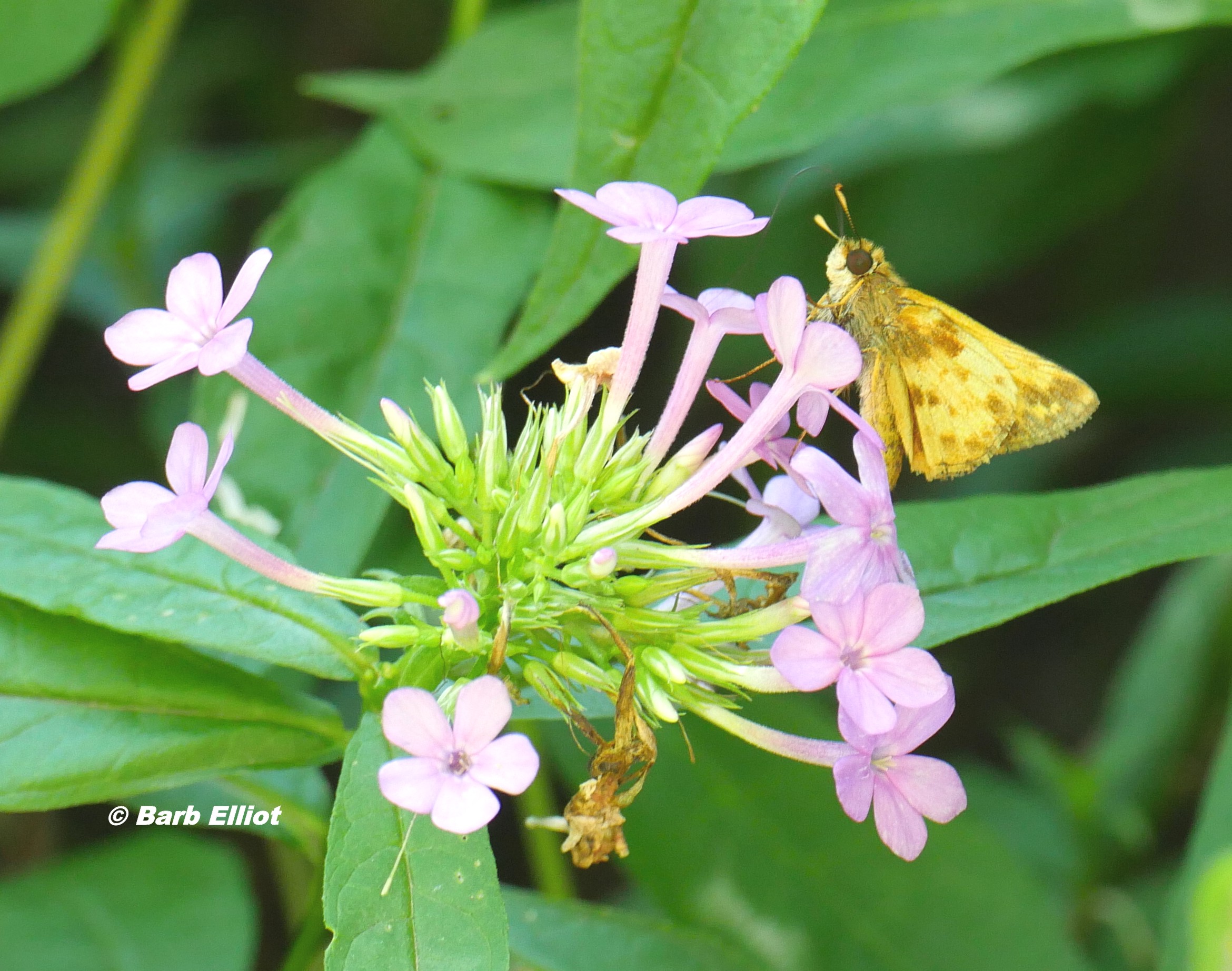
Skipper (probably Zabulon Skipper – Poanes zabulon) sipping nectar from Garden Phlox (Phlox paniculata ‘Jeana’). © Barb Elliot. Click to enlarge.
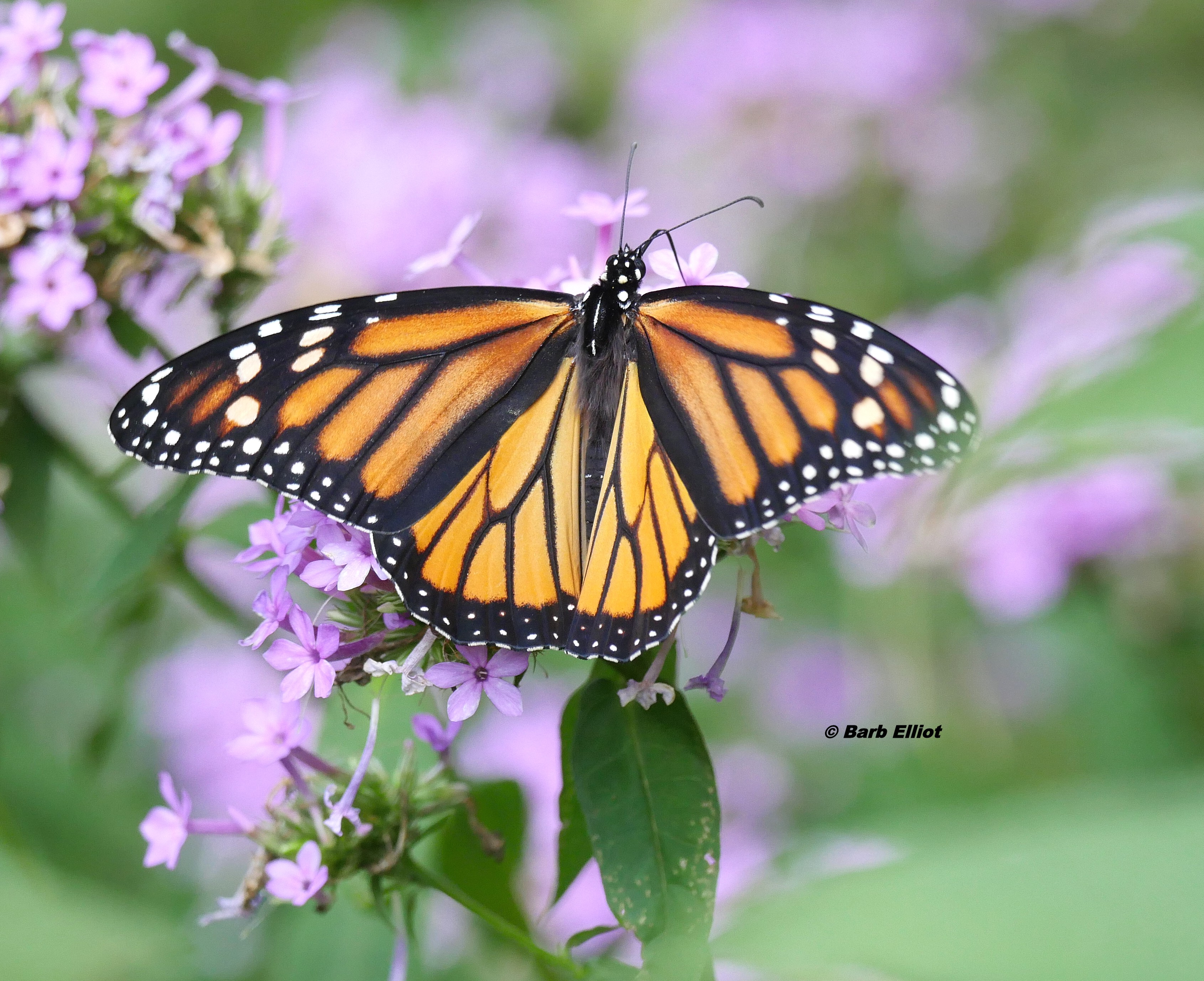
Monarch butterfly (female) on Garden Phlox (Phlox paniculata ‘Jeana’). © Barb Elliot. Click to enlarge.
Two ants in the grass struggle to drag a grub to their nest. The grub must weigh many times more than they do.
My Virgin’s Bower vine begins to bloom in late August and hosts a myriad of pollinators twenty-four hours a day.
At night, this vine is a moth magnet, attracting beauties like the multi-colored Ailanthus Webworm moth and Tobacco Budworm moth.
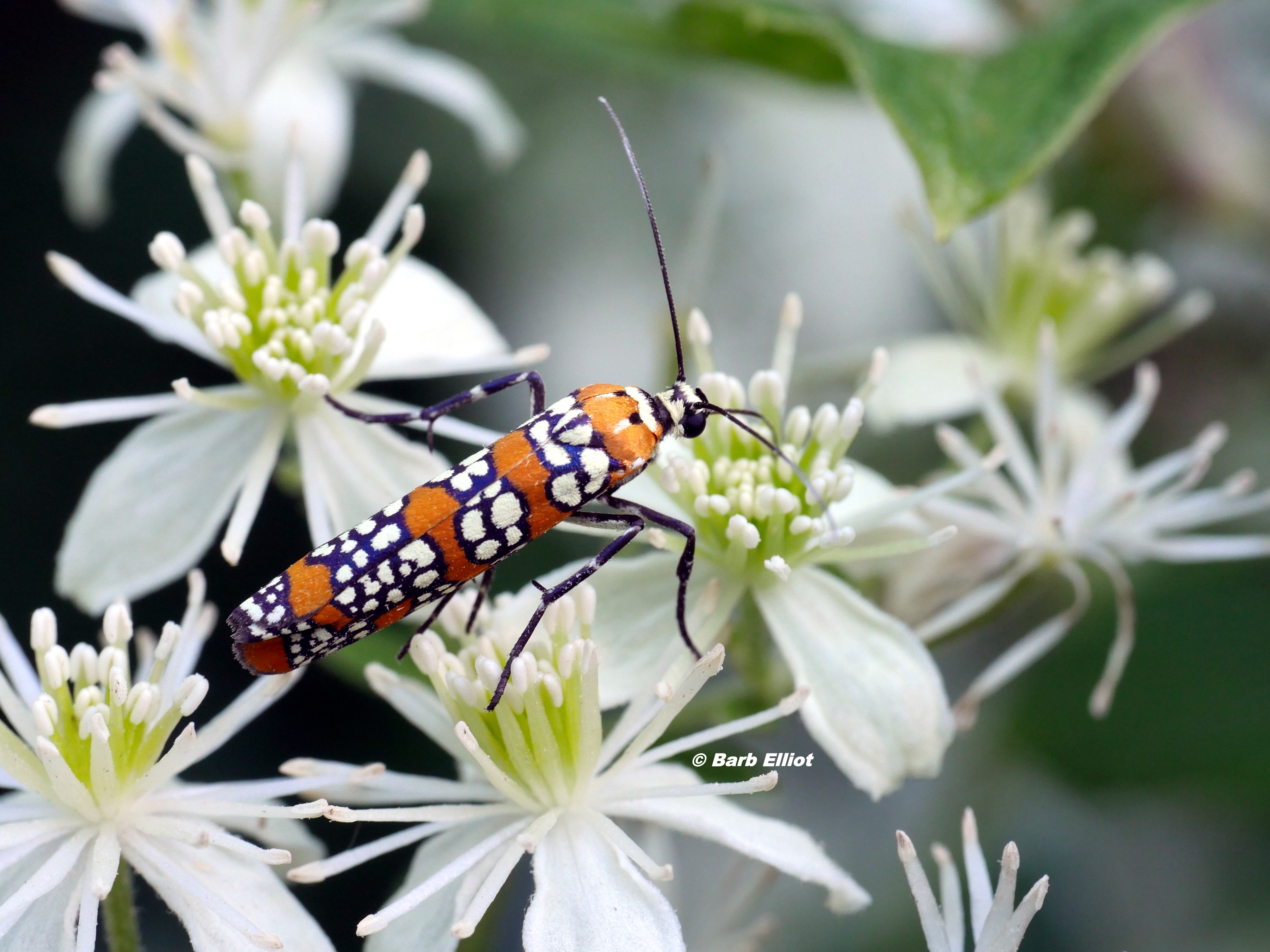
Ailanthus Webworm (Atteva punctella) moth sips nectar at night from Virgin’s Bower (Clematis virginiana). © Barb Elliot. Click to enlarge.
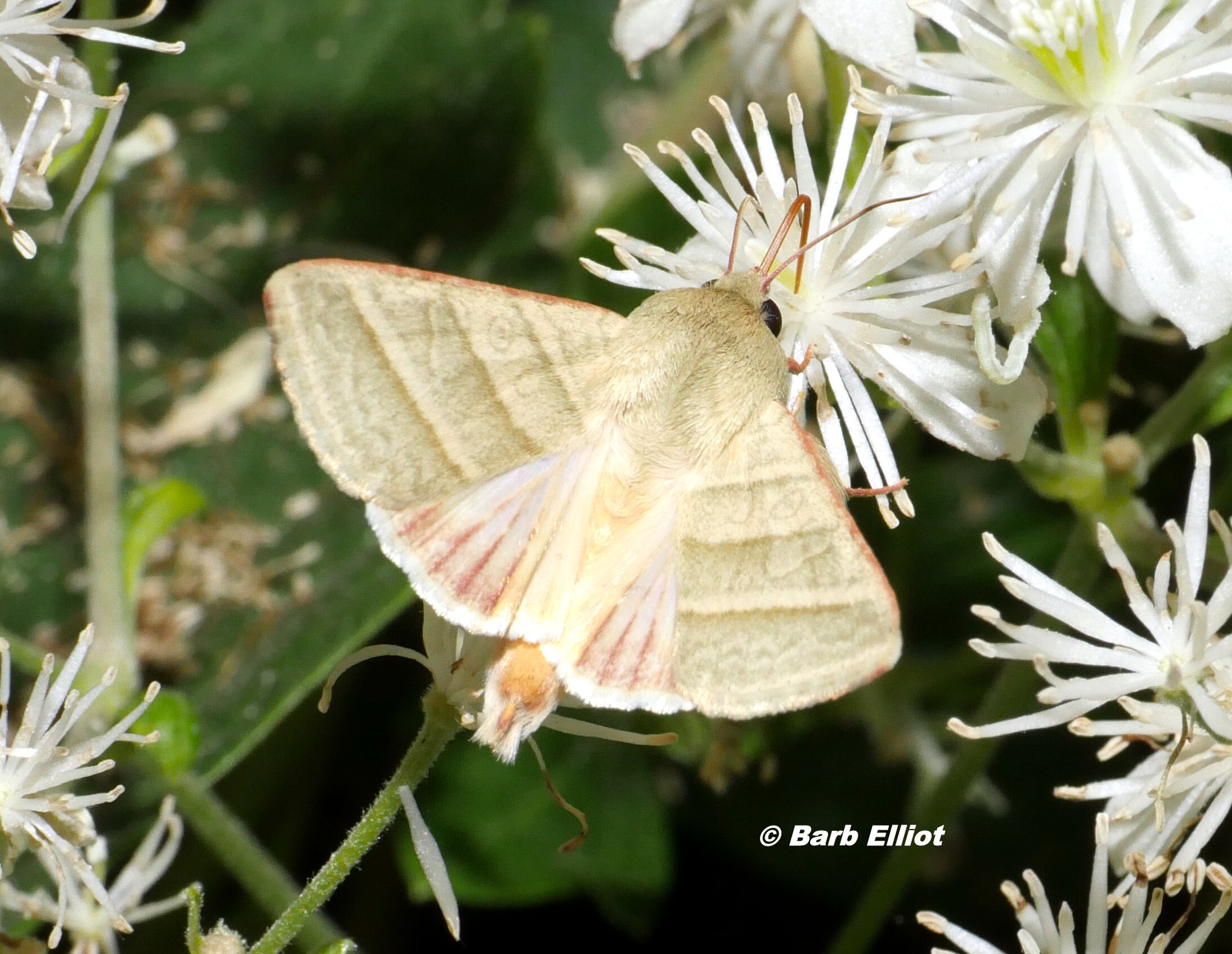
Tobacco Budworm (Heliothis virescens) moth sips nectar at night from Virgin’s Bower (Clematis virginiana). Note very small u-shaped caterpillar on flower to the right of the moth’s antennae. © Barb Elliot. Click to enlarge.
Predators such as harvestmen (“daddy longlegs”) and centipedes linger around the Virgin’s Bower vine to catch unsuspecting victims. As I watch, a Spotted Orb Weaver spider quickly paralyzes the moth that flies into its web and then wraps it in silk.

Spotted Orb Weaver (Neoscona crucifera) spider quickly paralyzes a moth that flies into its web. © Barb Elliot. Click to enlarge.
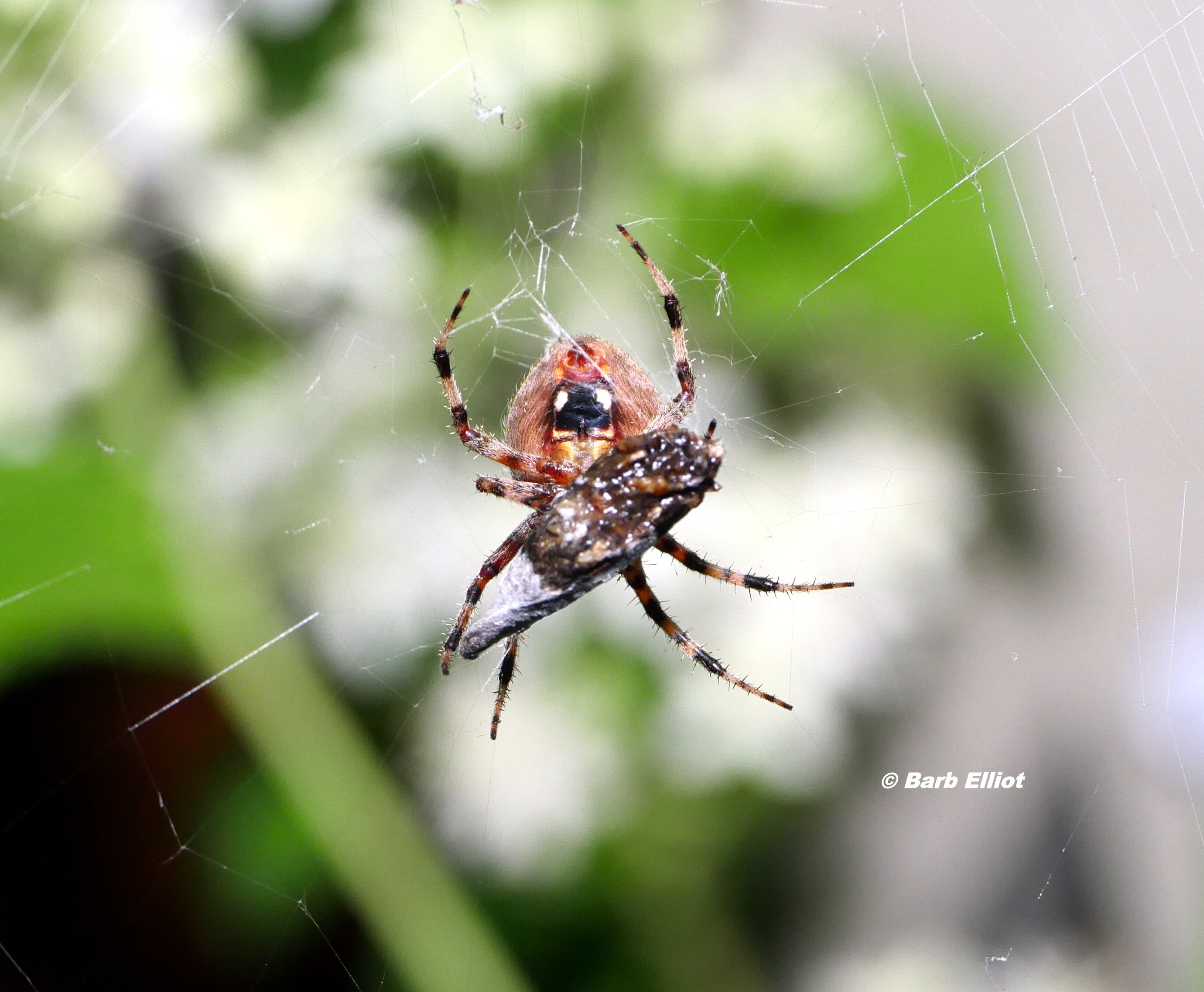
Spotted Orb Weaver (Neoscona crucifera) spider with moth wrapped in silk. © Barb Elliot. Click to enlarge.
By mid-September, I see some fall migrating birds in the yard, including a Northern Parula and Common Yellowthroat. Both find insects on my native plants that will fuel their journeys to the tropics.

a migrating Northern Parula (Setophaga Americana) in River Birch (Betula nigra) tree. © Barb Elliot. Click to enlarge.

A migrating Common Yellowthroat (Geothlypis trichas) hunts insects by the pond. © Barb Elliot. Click to enlarge.
A Red-spotted Purple caterpillar has eaten the tip of a Black Cherry leaf in a pattern characteristic of this species. I watch it grow for almost a week. Then one night I make a gruesome discovery. A spider has found my caterpillar and is in the process of sucking its life fluids. However, I find another small Red-spotted Purple caterpillar a few feet away. I’m hopeful this one will successfully overwinter and make it to adulthood. If so, next summer it will grace my yard as another beautiful Red-spotted Purple butterfly.

An early instar Red-spotted Purple (Limenitus arthemis) caterpillar on Black Cherry (Prunus serotina) . © Barb Elliot. Click to enlarge.
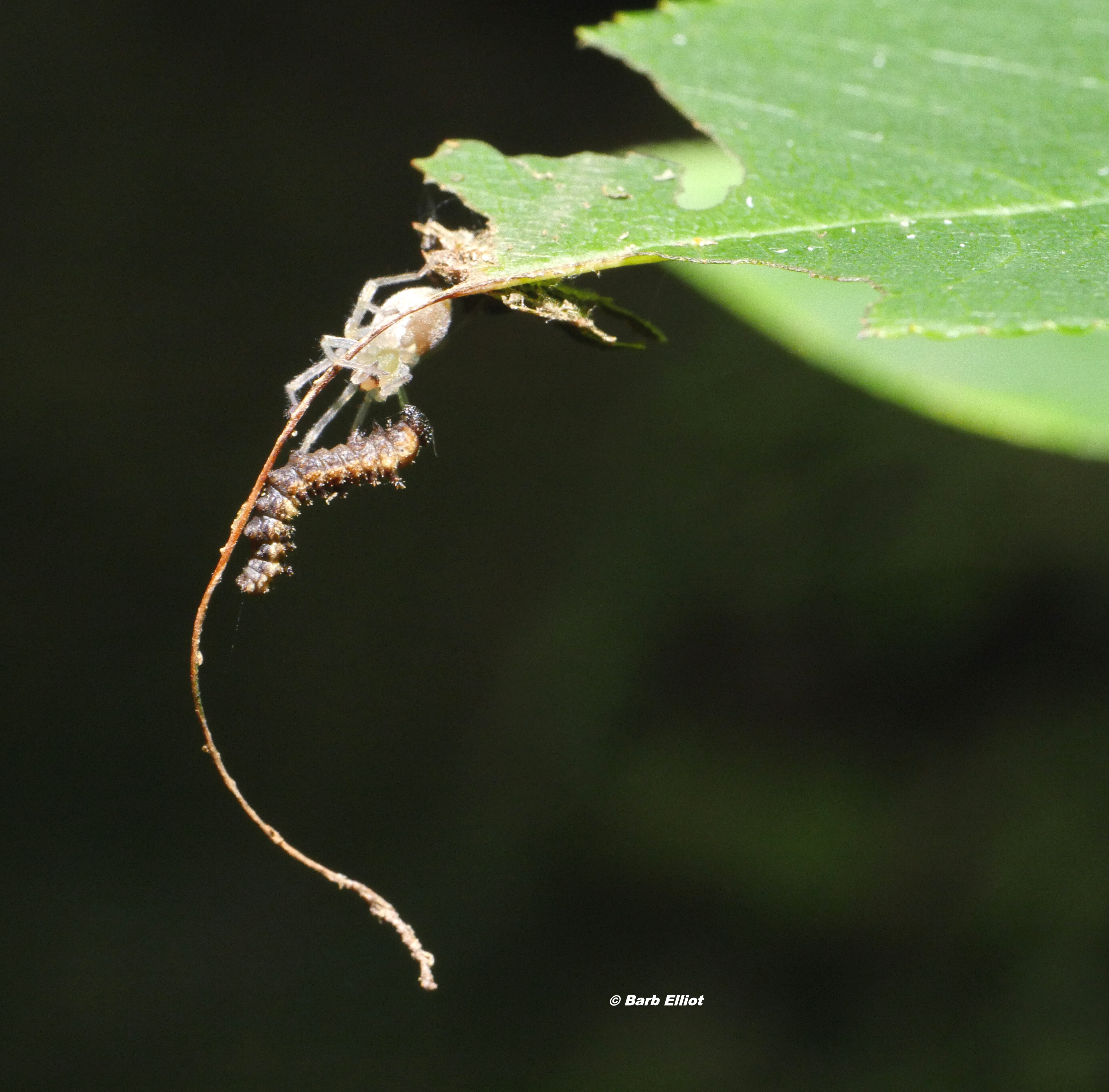
Spider sucking the life fluids of “my” Red-spotted Purple (Limenitus arthemis) caterpillar. © Barb Elliot. Click to enlarge.

Red-spotted Purple (Limenitus arthemis) butterfly on White Snakeroot (Ageratina altissima) in Barb’s yard. © Barb Elliot. Click to enlarge.
I look forward to next summer and discovering nature’s mysteries anew.
References
- Beadle, David & Leckie, Seabrooke. Peterson Field Guide to Moths of Northeastern North America. New York, NY: Houghton Mifflin Harcourt Brace Publishing Company, 2012
- Bug Guide.Net: http://bugguide.net/node/view/15740
- Evans, Arthur V. Beetles of Eastern North America. Princeton, N.J: Princeton University Press, 2014.
- Evans, Arthur V. Field Guide to Insects and Spiders of North America. New York, NY: Sterling Publishing Company, Inc., 2008.
- Moth Photographer’s Group: http://mothphotographersgroup.msstate.edu/
- Switzer, Callin, “Getting Buzzed at the Arnold Arboretum”, Arnoldia; April, 2014.

